Japan Itinerary for First-Time Travellers: A 21-Day Adventure
In late 2023, we spent 21 days exploring Japan. This was our first visit, and we designed our Japan itinerary to strike a balance between iconic highlights and quieter cultural experiences, all at a relaxed and enjoyable pace.
This detailed, day-by-day itinerary shares exactly what we did, what we loved, what we’d change, and helpful tips for anyone planning a similar trip.
🎧 Want to hear us talk through it? We recorded two Global Travel Planning Podcast episodes to accompany this trip:
🛋️ Planning your first trip?
- Read our complete guide: Essential Tips for First-Time Visitors to Japan. We cover everything from transport and etiquette to packing suggestions and cultural tips to help you feel confident and prepared.
Note: This itinerary was based on the Japan Rail Pass system in 2023. Since then, there have been changes to pricing and availability. Be sure to check the latest information before purchasing a JR Pass.
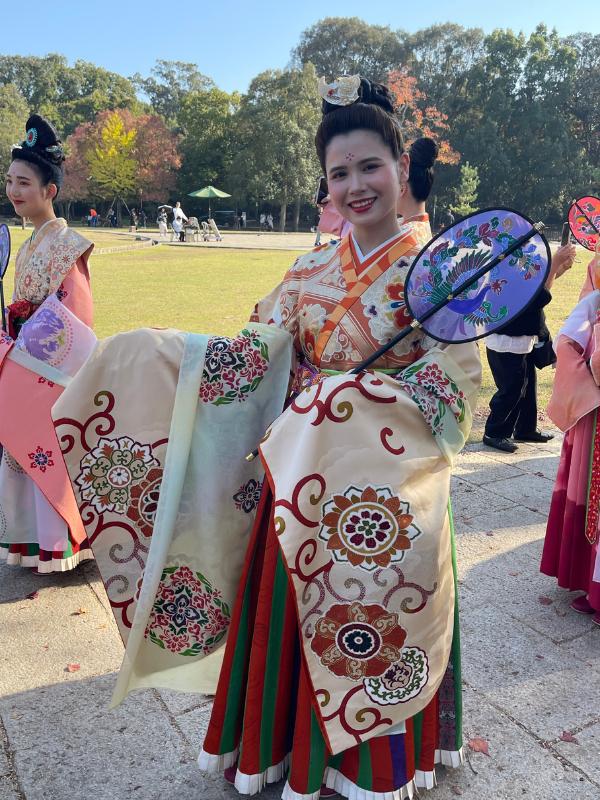
Japan Travel Cheatsheet
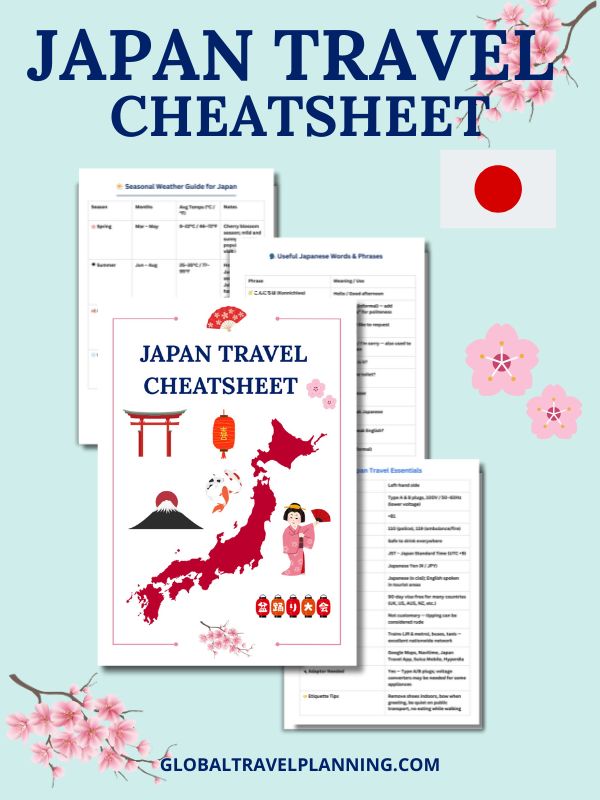
Accommodation + Tours
- Yudanaka Yasuragi – Onsen
- Chisun Grand Takayama – Takayama
- Stay Sakura Kyoto – Kyoto
- Hotel Granvia Hiroshima – Hiroshima
- Hotel Hankyu Respire – Osaka
21 Day Japan Itinerary
Day 0 – Arrival in Tokyo
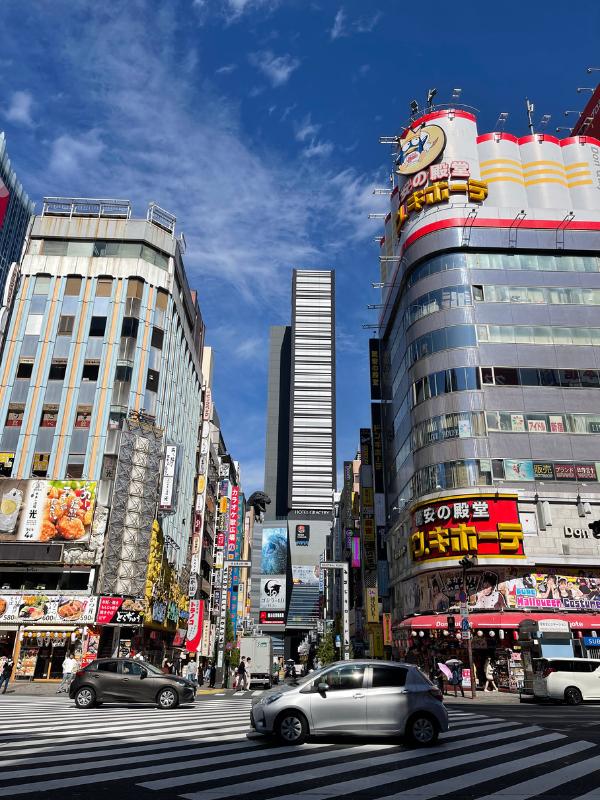
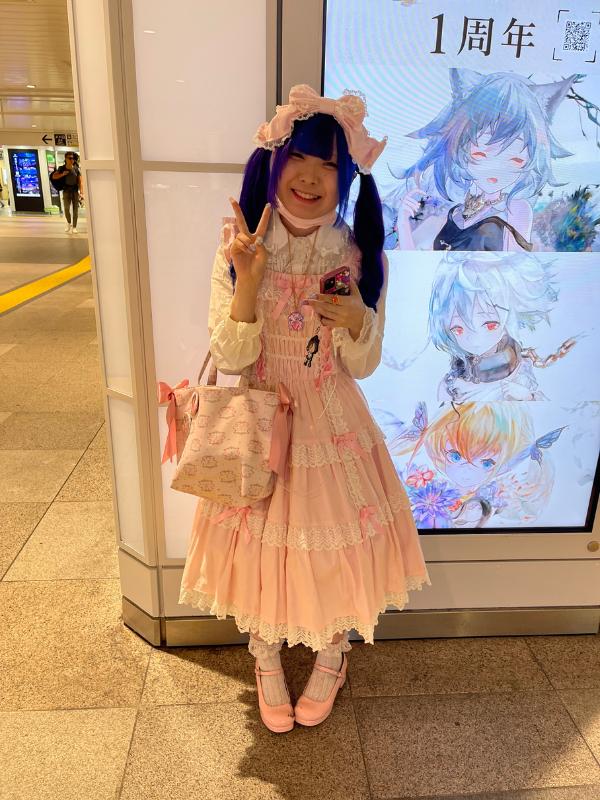
After landing at Tokyo’s Narita Airport, we spent around 90 minutes getting through immigration and baggage claim. We had arranged a private transfer to our accommodation in central Tokyo, which took approximately 35 minutes.
Our accommodation was situated between Shinjuku Station and Okubo Station, making it a convenient base from which to explore Tokyo. After settling in, we explored the surrounding area and stopped at a 7-Eleven one of Japan’s excellent convenience stores.
Travel Tip: Don’t overlook Japan’s convenience stores, such as 7-Eleven, FamilyMart, and Lawson. They’re incredibly useful and offer:
- Excellent ready-to-eat meals (hot and cold), including their must-have egg sandwiches!
- Toilets and ATMs
- Photocopying and printing services
- Luggage delivery arrangements
- They’re clean, reliable, and open late (or 24/7 in most cases).
Day 1 – Shinjuku & Meiji Jingu Shrine
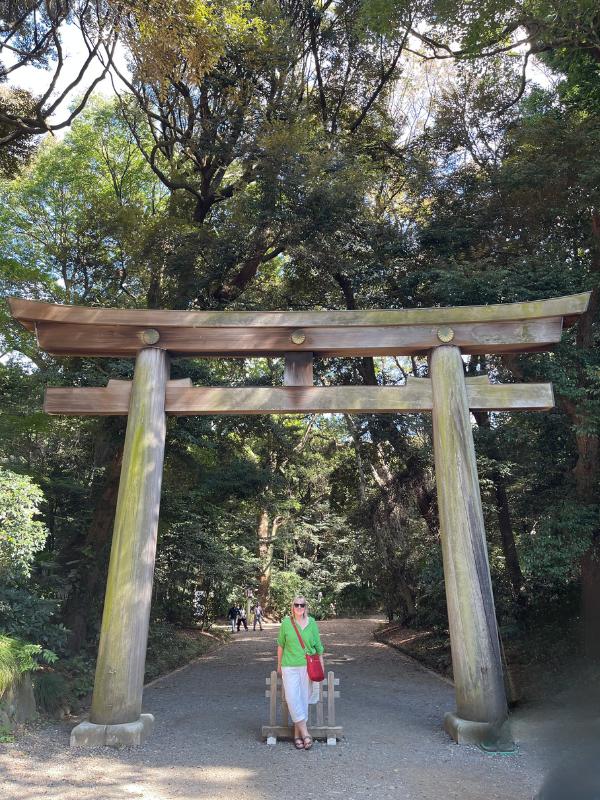
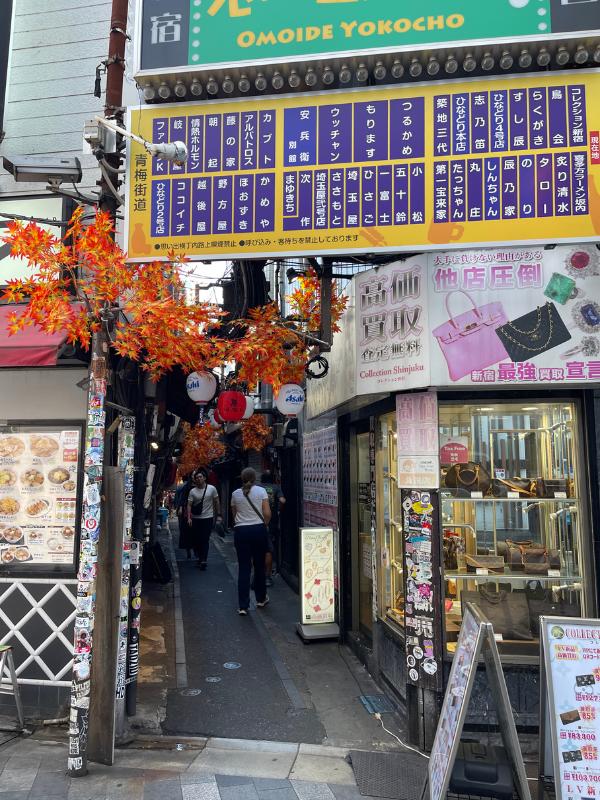
We began our day by walking to Shinjuku Station to exchange our Japan Rail Pass vouchers and set the pass to activate in one week as we planned to stay in Tokyo for the first part of our trip.
This gave us time to explore the city using IC cards like Suica or Pasmo (which can be added to Apple or Google Wallet for convenience).
Our first sightseeing stop was Meiji Jingu Shrine, a peaceful Shinto shrine surrounded by forested paths. We got there by taking a local bus from Shinjuku.
We wandered around the serene shrine grounds, enjoyed a picnic in the nearby park, and took in the calming atmosphere away from Tokyo’s hustle.
For the return, we took a train from Harajuku Station back toward Okubo Station, transferring along the way. The journey back helped us familiarise ourselves with the Tokyo transport system.
Steps walked: Approx. 12,000
Tip: Wear comfortable walking shoes as you’ll be covering a lot of ground
Day 2 – Tokyo Circuit: Shrines, Crossings & Culture
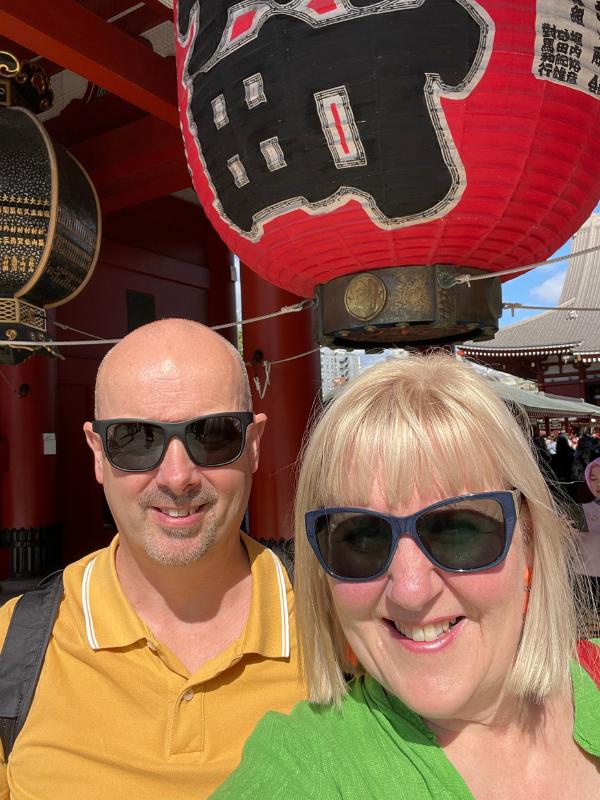
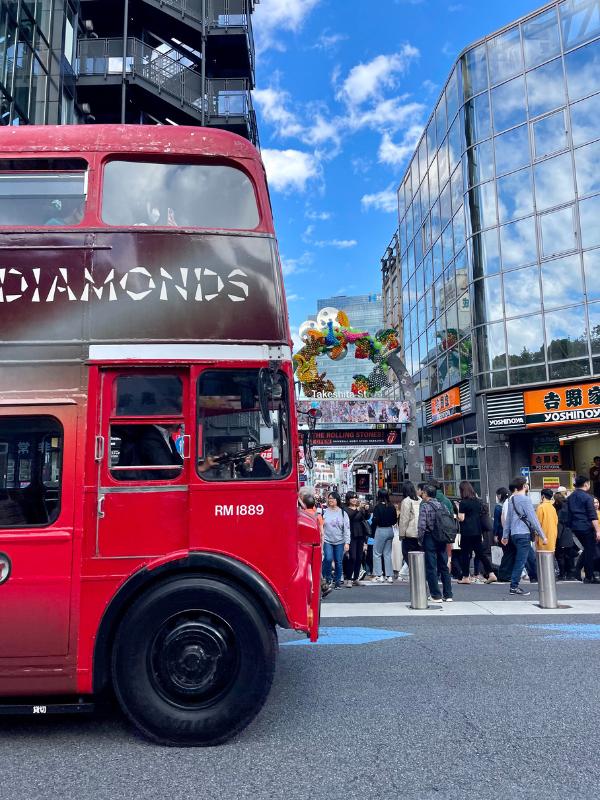
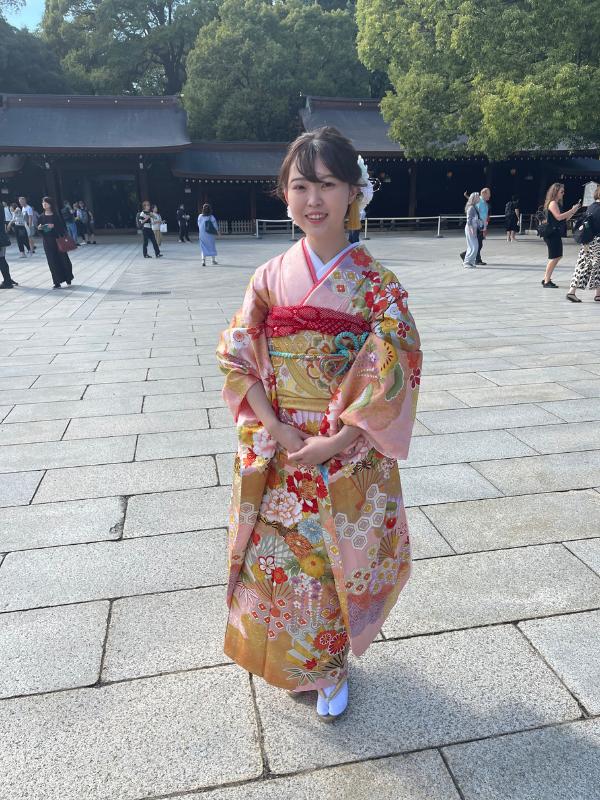
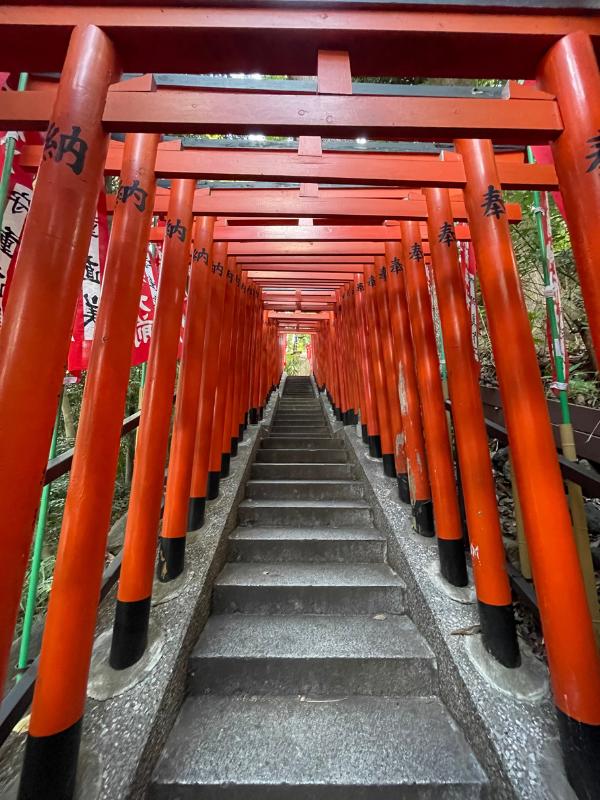
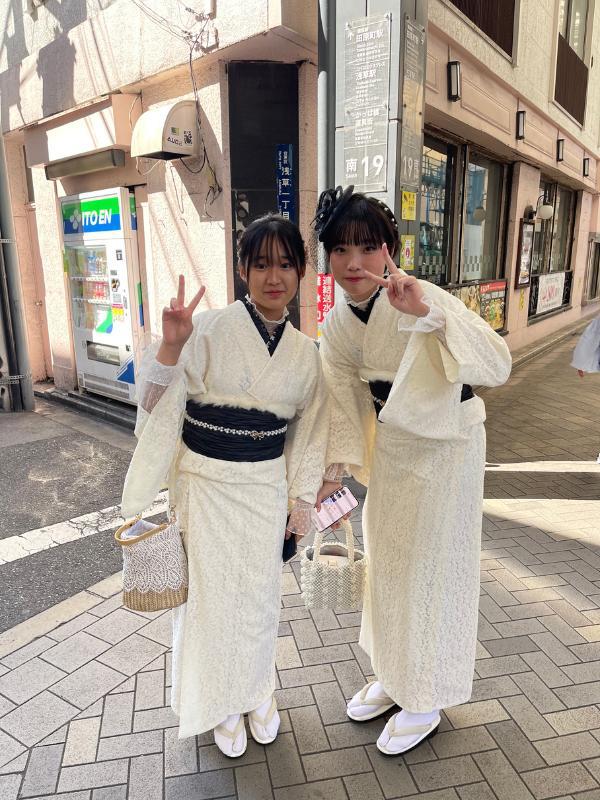
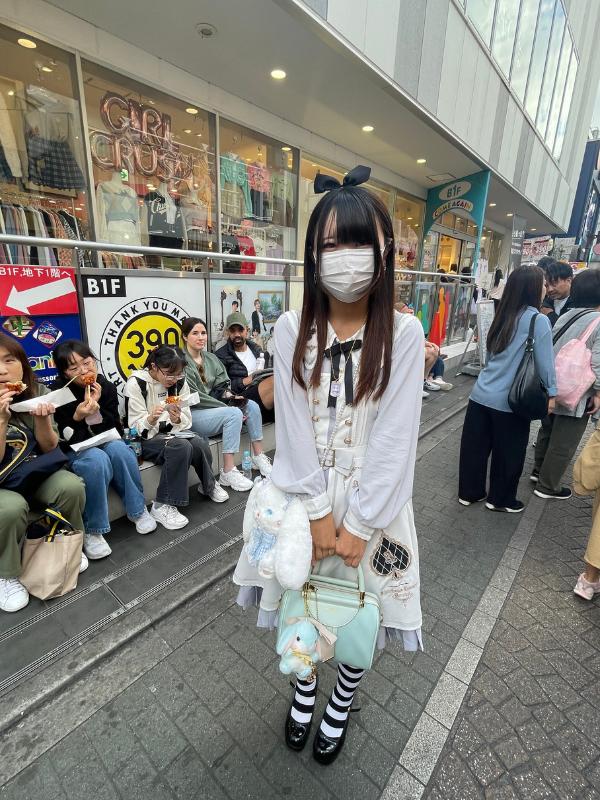
This day is a great example of how much you can fit into one day in Tokyo with a little planning. We used our Suica card (added to our phones) to travel efficiently around the city by train.
Here’s the full route we followed which is an ideal Tokyo itinerary for a first-time visitor:
🛕 Stop 1: Hie Shrine
We started the day at Hie Shrine, a lesser-known but beautiful Shinto shrine tucked away in central Tokyo. It’s known for its striking red torii gates, which create a tunnel-like walkway perfect for photos and a peaceful start to the morning.
🏮 Stop 2: Sensō-ji Temple
From Hie Shrine, we travelled to Sensō-ji Temple in Asakusa, Tokyo’s oldest temple. Famous for its Kaminarimon Gate and giant red lantern, the temple grounds are atmospheric and often busy, but it’s a must-see. Take time to walk down Nakamise-dori, the shopping street leading up to the temple, lined with traditional snacks and souvenirs.
🚥 Stop 3: Shibuya Crossing
Next, we visited the iconic Shibuya Crossing, one of the busiest pedestrian intersections in the world. You can watch the chaos from above at one of the cafes or just experience walking across it — a fun, energetic moment that captures modern Tokyo.
🛍️ Stop 4: Takeshita Street (Harajuku)
We ended our day at Takeshita Street in Harajuk, famous for youth fashion, quirky shops, and sweet treats like crepes and rainbow candy floss. It’s an excellent place for people-watching and a contrast to the traditional sights earlier in the day.
Steps walked: Around 12,000
Transport used: Tokyo Metro (paid using Suica card)
🔍 Planning Tips for This Itinerary
- Map your route ahead of time: We planned this route in advance by checking which metro lines to take and in what order. It made the day far more efficient and reduced stress while navigating.
- Arrive early for photos: Places like Sensō-ji and Shibuya Crossing can get very crowded later in the day. If photography is a priority, go early.
- Bring your own drinks/snacks: While there are vending machines everywhere, seating areas are limited in many sightseeing spots. It’s a good idea to bring drinks and any snacks you may want — just be respectful about where you eat.
Day 3 – Mount Fuji Day Tour from Tokyo 🚐🗻
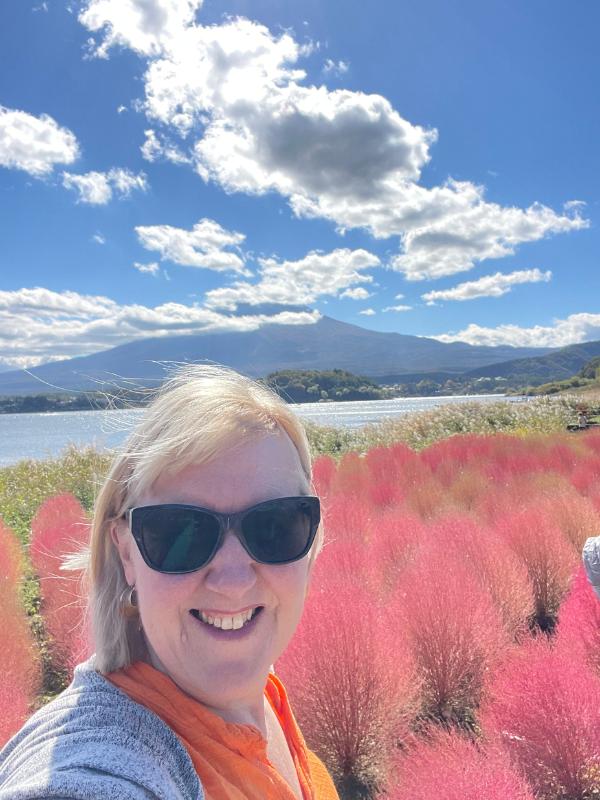
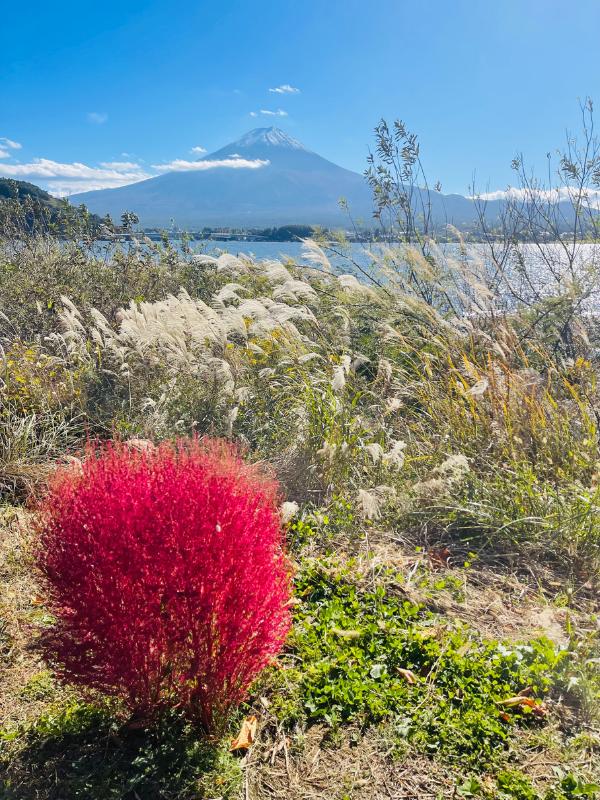
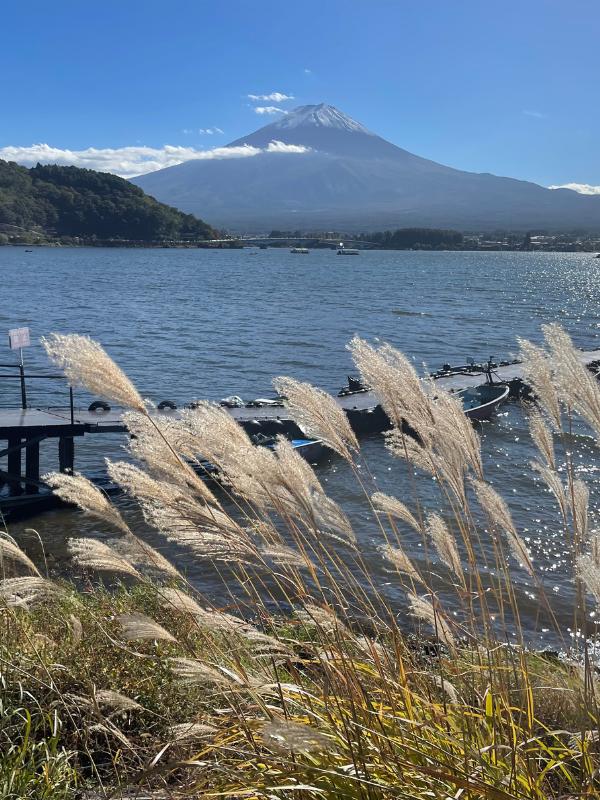
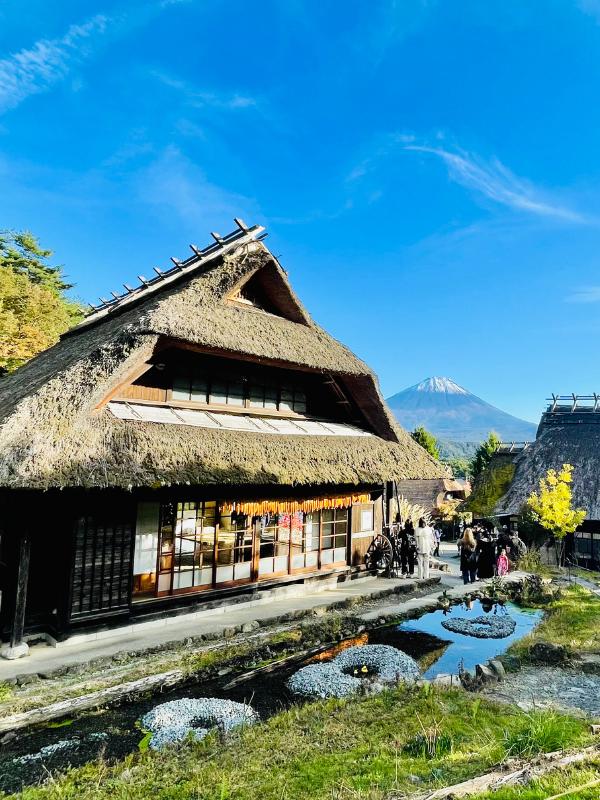
On Sunday, 22 October, we joined a full-day Mount Fuji tour from Tokyo, booked via GetYourGuide. This popular tour included scenic stops around Lake Kawaguchi, charming traditional villages, and panoramic views of Mount Fuji (weather permitting).
We were picked up at 8.20am in Shinjuku and departed by 8.30am. The tour order was changed slightly on the day due to a local festival, which caused heavy traffic and limited access to some sites. However, our guide Mitsu managed the day well and adjusted the route to make the most of it.
🛑 Stop 1: Oishi Park
Normally visited later in the tour, Oishi Park was our first stop due to traffic changes. It’s a peaceful lakefront garden with flower beds and views across Lake Kawaguchi toward Mount Fuji.
It took around 3 hours to reach the area due to Sunday traffic, which is something to consider when planning this trip on a weekend.
🍱 Stop 2: Lunch at Lake Kawaguchi
We stopped briefly at a 7-Eleven for lunch, another example of how convenient and reliable Japan’s convenience stores are. From our roadside stop, we enjoyed scenic lake views (although it was cloudy that day).
Ice Cream Alert: We sampled unusual but delicious flavours like plum, peach, and muscat grape!
🏯 Stop 3: Saiko Iyashi-no-Sato Nenba (Japanese Village)
Next, we visited this open-air museum and traditional village at the base of Mount Fuji. It features thatched-roof houses, craft shops, and cultural exhibits, a lovely place to explore for around 50 minutes. It’s a great spot to learn more about rural life in historic Japan and enjoy some local snacks or souvenirs.
🛕 Stop 4: Chureito Pagoda at Arakurayama Sengen Park
Our final stop was Arakurayama Sengen Park, home to the iconic Chureito Pagoda. The climb involves 398 steps, but it’s well worth it for the sweeping view of Mount Fuji and the city below especially during cherry blossom or autumn foliage season.
Unfortunately, by the time we arrived it was getting dark and the clouds had rolled in, so visibility was limited. Still, the experience was memorable and the hike invigorating.
🚗 Return to Tokyo
The journey back to Tokyo took around 3.5 hours due to weekend traffic.
💡 Tips for Visiting Mount Fuji on a Day Tour
- Avoid weekends if possible. Traffic on Sundays can be severe, adding hours to travel time.
- Be flexible. Local events or weather may cause changes to the itinerary, and our guide rearranges stops for efficiency.
- Prepare for steps. The climb to Chureito Pagoda is steep (398 steps), so wear comfortable shoes and take your time.
- Pack snacks and water. While konbini stores are excellent, it’s good to have something on hand in case of delays.
- Check visibility forecasts. Mount Fuji is often shy! Clear skies offer the best views, but the experience remains worthwhile even on cloudy days.
Day 4 – TeamLab Planets & Tokyo Station: Art Meets Travel Prep
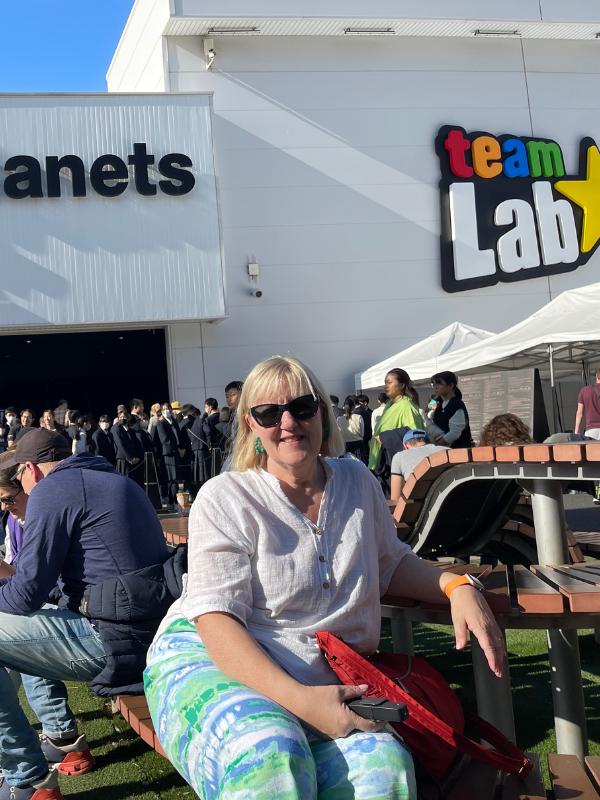
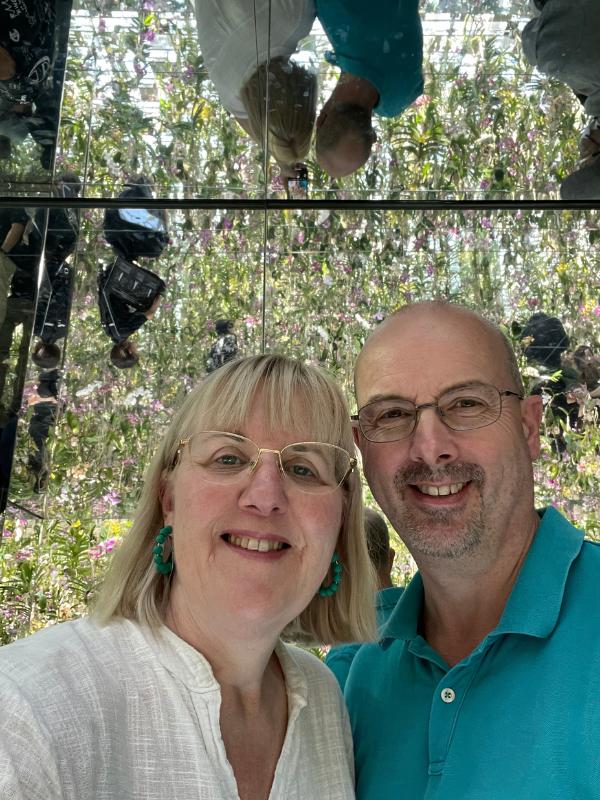
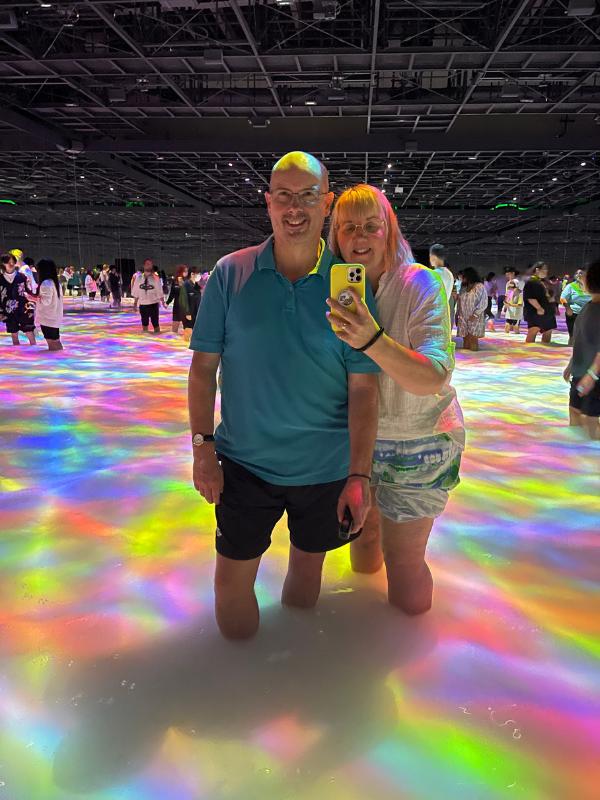
On Monday, 23 October, we started the day with one of Tokyo’s most unforgettable experiences, a visit to TeamLab Planets Tokyo, a digital art museum that’s immersive, interactive, and unlike anything else.
🎨 Morning: TeamLab Planets Tokyo
Located in Toyosu, TeamLab Planets is an immersive art installation where you walk through water, mirrored rooms, and mind-bending digital displays. It’s a multi-sensory experience and a highlight of our trip.
⭐ Our rating: 10/10: absolutely unmissable!
📝 TeamLab Planets Tips:
- Book in advance: This is a very popular attraction and often sells out days ahead.
- Don’t bring large bags: You’ll need to remove your shoes and wade through water — lockers are available on-site.
- Wear shorts or trousers you can roll up: You’ll be walking through ankle-deep water as part of the experience, so avoid long skirts or wide trousers.
- Be aware of mirrors and glass floors: Some rooms have mirrored surfaces, so consider your outfit accordingly.
We spent around 2 hours here, which is the ideal amount of time to fully enjoy each room without rushing.
🍱 Afternoon: Tokyo Station & Shinkansen Prep
After TeamLab, we headed to Tokyo Station to collect our Shinkansen tickets and check logistics for an upcoming journey. It was a smooth process and a good time to familiarise ourselves with the station layout, which is helpful if you’re taking trains from there later.
While at Tokyo Station, we grabbed dinner and snacks for the next day from two great spots:
- Eggslut – A trendy spot known for rich, egg-based sandwiches.
- Boulangerie – Great for pastries, bread, and takeaway options.
Both places are located in the same building, making it easy to sit down for a meal and pick up food to go.
Tip: Tokyo Station is more than just a transport hub – it’s also a foodie haven. Arrive early to explore the food halls, bento shops, or grab essentials for your train journey.
Day 5 – Tokyo Skytree & Imperial Palace Gardens
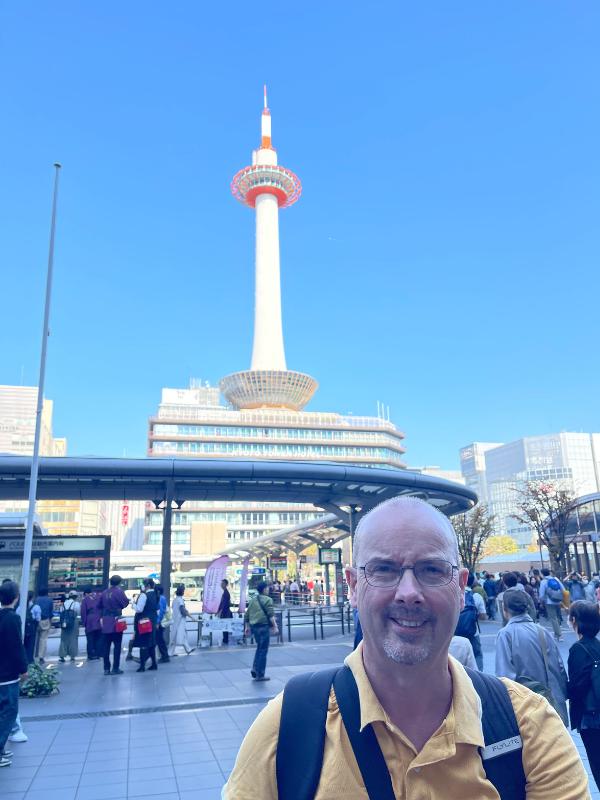
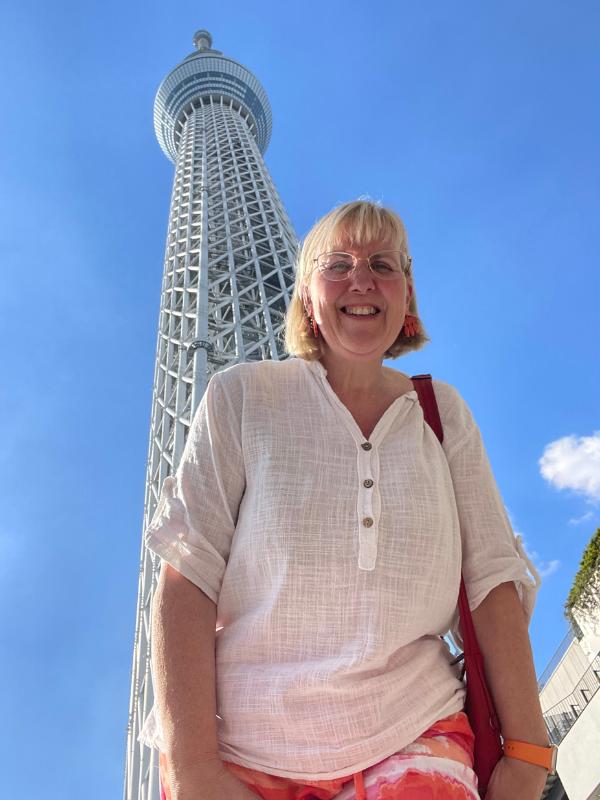
On Tuesday, 24 October, we planned a lighter sightseeing day, visiting two of Tokyo’s most well-known attractions — the Tokyo Skytree and the Imperial Palace Gardens.
🗼 Morning: Tokyo Skytree
We had pre-booked tickets for 11am at the Tokyo Skytree, Japan’s tallest structure and one of the tallest towers in the world. The observation deck offers panoramic views across Tokyo, and on clear days you can see Mount Fuji in the distance.
Our rating: 7/10
It’s a solid experience for first-time visitors, though the crowds and queuing times can reduce the enjoyment a little. Still, if you love views and cityscapes, it’s worth a visit.
Tip: Book your tickets in advance to secure your preferred time slot and avoid long wait times.
🌿 Afternoon: Imperial Palace & East Gardens
After Skytree, we headed to the Imperial Palace and its East Gardens, a large parkland area in central Tokyo. While the grounds are peaceful and well-kept, we didn’t find it as engaging as other attractions in the city.
Our rating: 2–3/10
The gardens are free to enter and nice for a walk, but they’re quite plain and may not be worth prioritising if your time is limited.
Tip: If you’re a fan of Japanese gardens, you might prefer Shinjuku Gyoen or Rikugien Garden instead for a more scenic experience.
Note: We were still based in Shinjuku for our Tokyo stay, a convenient location with excellent transport connections and plenty of food and shopping options.
Day 6 – Luggage Forwarding & Hana-Biyori Gardens
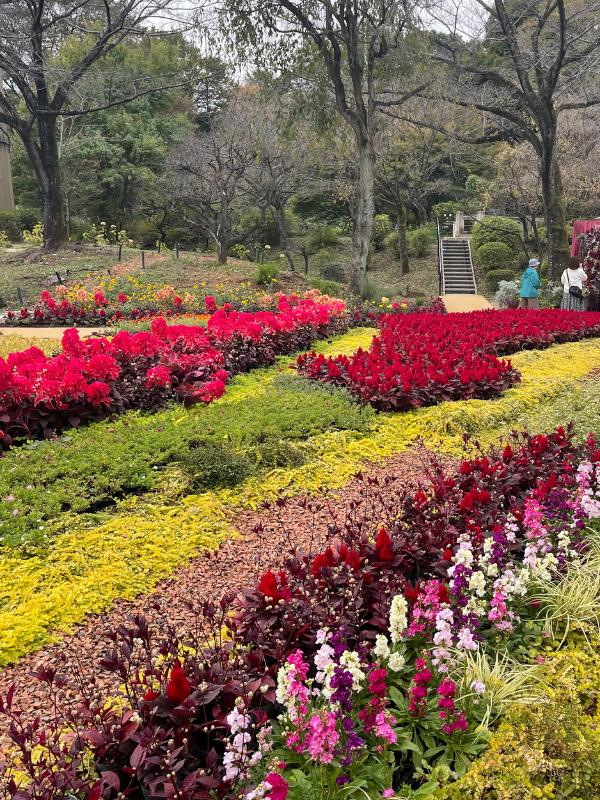
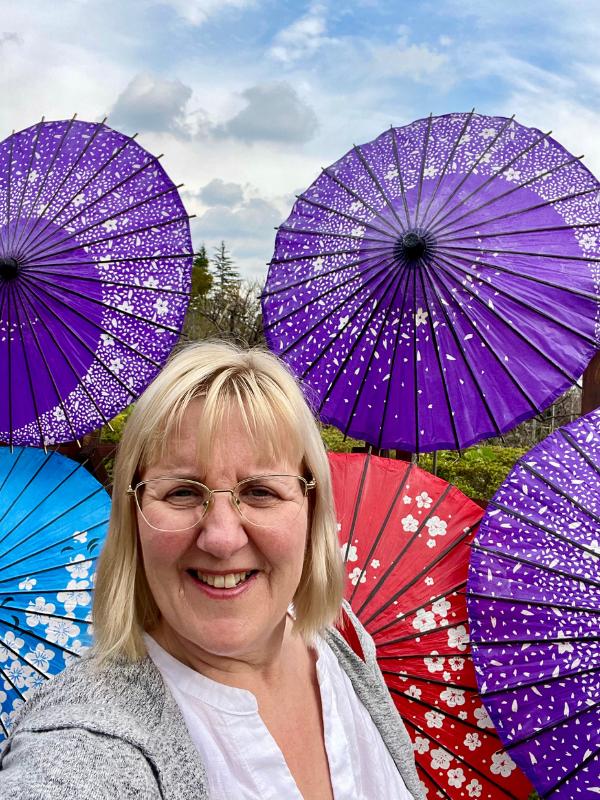
On Wednesday, 25 October, we used one of Japan’s most convenient travel services – luggage forwarding – to send our suitcases ahead to our next destination, Kyoto.
📦 Luggage Forwarding in Japan
Japan’s luggage forwarding services (like Yamato Transport / TA-Q-BIN) are efficient, affordable, and widely available at hotels and convenience stores. It allowed us to travel light and comfortably for the next part of our trip.
Tip: You can usually send your bags overnight or with a slight delay depending on your destination. Simply ask your accommodation for assistance. It’s a great option when travelling by train or when you have limited luggage storage.
🌸 Afternoon: Hana-Biyori Gardens
After sending our luggage, we visited the Hana-Biyori Gardens, located near the Yomiuriland theme park on the outskirts of Tokyo. The gardens feature colourful flower displays and a greenhouse with seasonal blooms.
Our rating: 5/10
While the gardens were pleasant and visually appealing, we wouldn’t consider it a must-see. We chose to visit after seeing photos online, but unless you’re already in the area or a big fan of botanical gardens, it may not be worth the trip out.
Day 7 – Shinkansen to Yudanaka and a Traditional Ryokan Experience
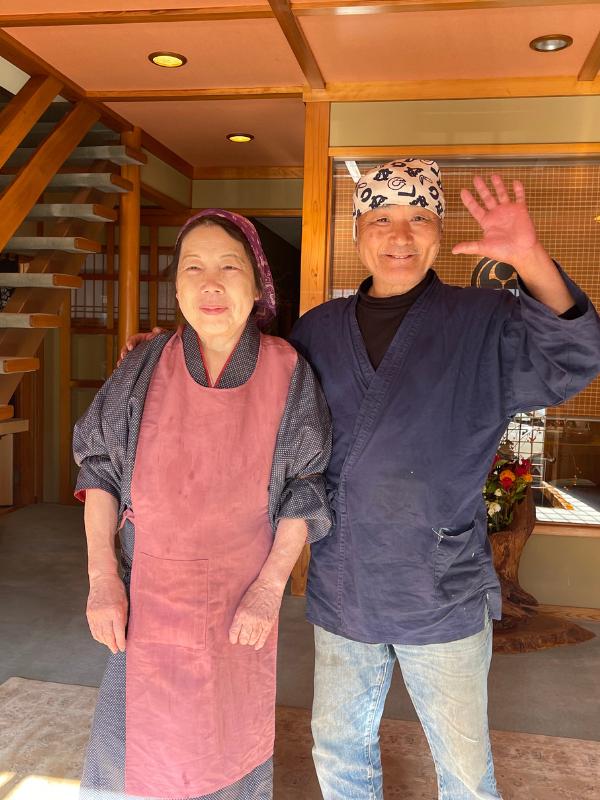

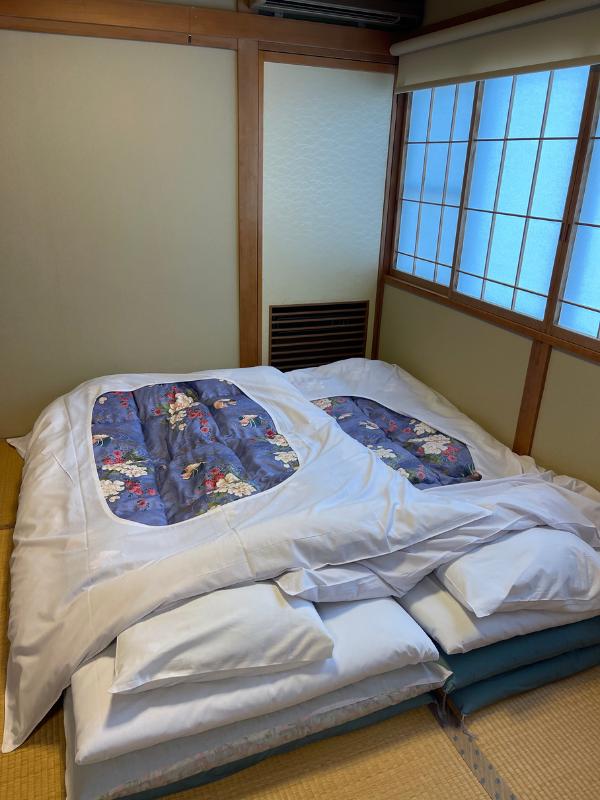
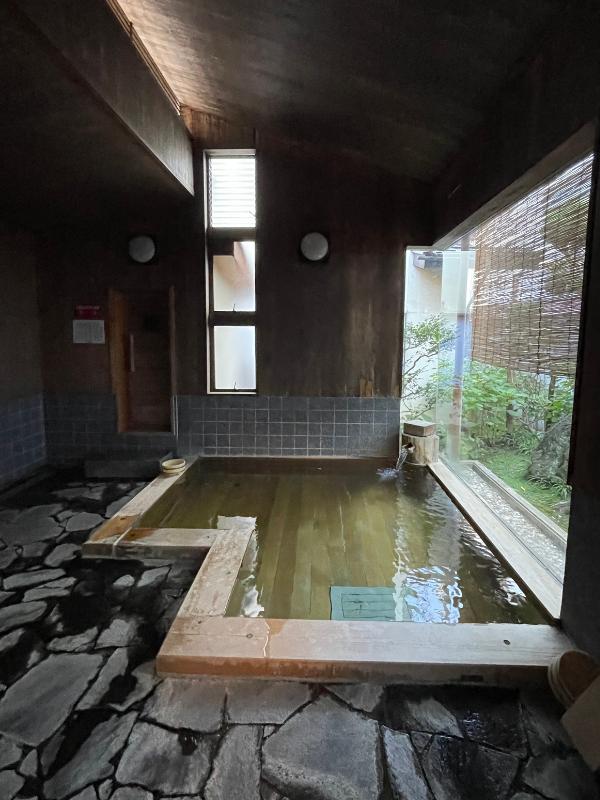
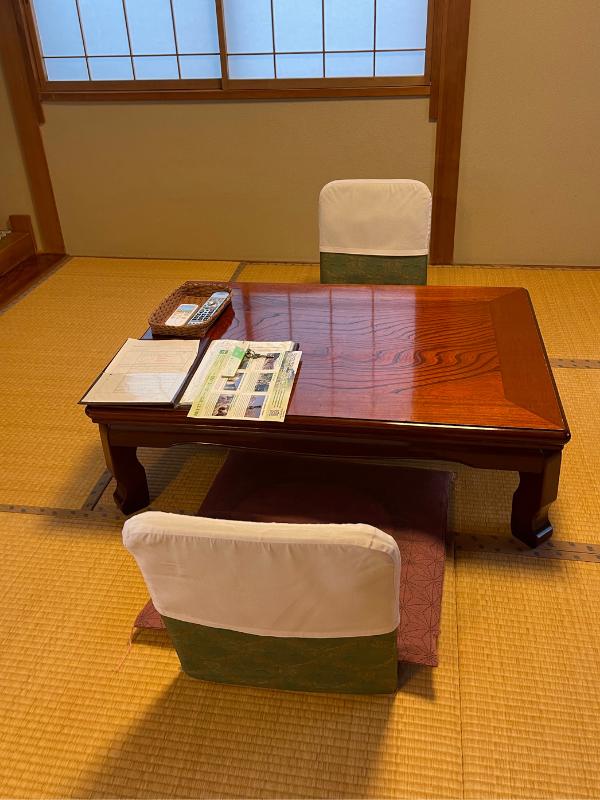
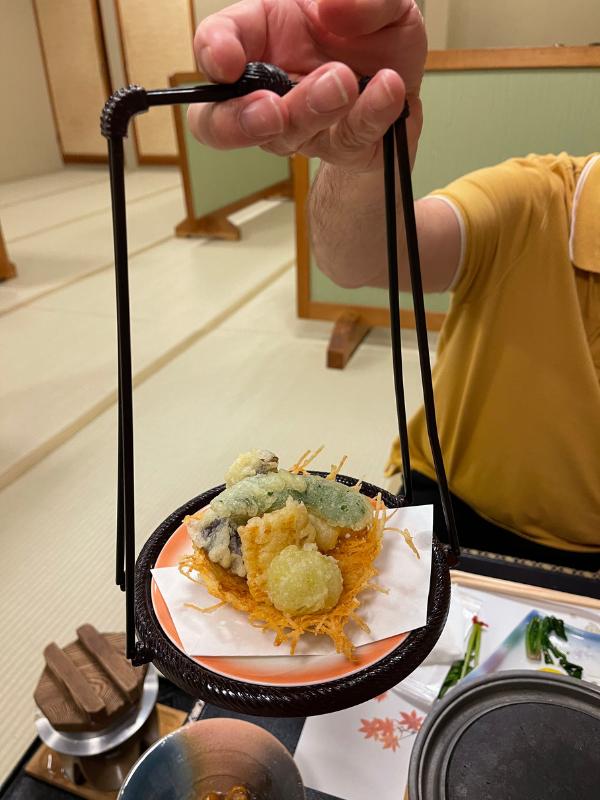
On Thursday, 26 October, we left Tokyo and headed into the mountains for a more traditional Japanese experience, taking the train to the peaceful town of Yudanaka.
🚄 Tokyo to Yudanaka by Train
We boarded the Shinkansen from Tokyo Station to Nagano, which took 1 hour and 29 minutes. From Nagano Station, we transferred to the Nagano Dentetsu Line toward Yudanaka, a small town known for its hot springs and mountain atmosphere.
Tip: The transfer at Nagano Station is straightforward. The JR Pass does not cover trains on the local Nagano Dentetsu line, so have some cash or an IC card ready.
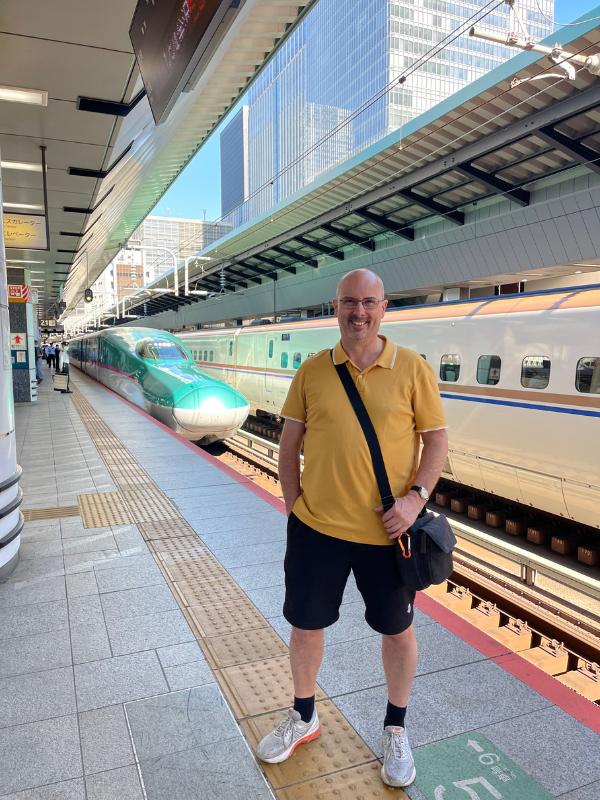
🏯 Staying in a Traditional Ryokan
In Yudanaka, we stayed in a ryokan, a traditional Japanese inn offering a peaceful, culturally immersive stay. Ours included both dinner and breakfast, with beautifully presented meals using local and seasonal ingredients.
The highlight of our stay was the private onsen bath attached to the ryokan. This was ideal for us, as we preferred not to use public baths which require full nudity. Having a private onsen gave us the opportunity to experience this part of Japanese culture in comfort.
The elderly couple who owned the ryokan were warm and welcoming, making our stay feel truly special.
🏯 What to Expect When Staying in a Ryokan
Staying in a ryokan is one of the most authentic and memorable experiences you can have in Japan. These traditional inns focus on hospitality, simplicity, and local culture. Here’s what to expect:
👟 Remove Your Shoes at the Entrance
As with many places in Japan, you must remove your shoes before entering the ryokan. You’ll usually be given indoor slippers to wear inside the building.
🛌 Tatami Mat Rooms
Ryokan rooms are covered with tatami mats (woven straw flooring). Instead of Western-style beds, you’ll sleep on a futon mattress that is laid out directly on the floor. It’s part of the charm and comfort of the experience.
👘 Yukata Robes
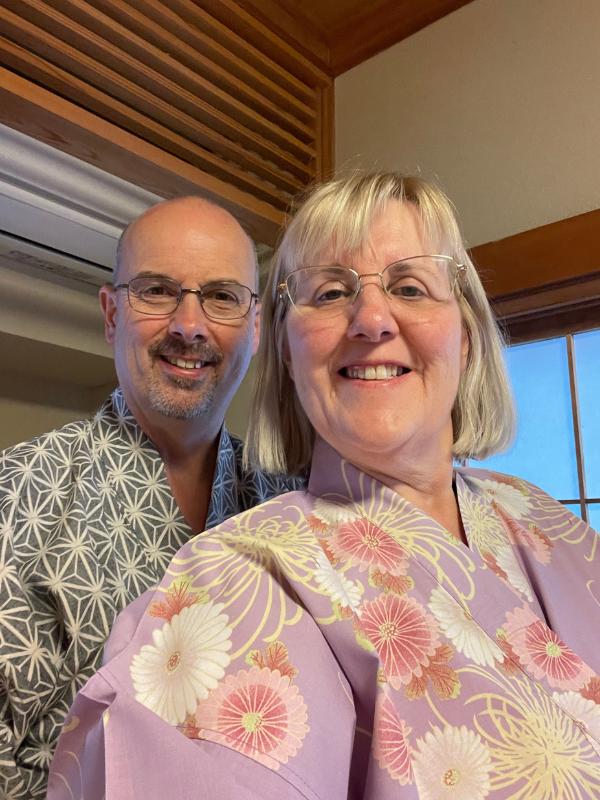
You’ll be provided with a yukata, a casual cotton robe worn during your stay. This is not a formal kimono but is commonly worn in ryokans to meals, to the bath, and while relaxing in your room. Slippers and sometimes a sash belt are also included.
🍵 Tea Service
Your room will typically include a small tea set with green tea, often accompanied by a sweet treat. It’s a lovely welcome ritual and a chance to settle in.
♨️ Onsen Baths (Hot Springs)
Many ryokans offer onsen baths — natural hot spring baths used for relaxation and health benefits. Our ryokan had two private onsens, which we preferred as it allowed us to bathe in privacy.
- Onsen etiquette:
- Wash your body thoroughly before entering the bath
- Enter the bath completely naked (no swimwear allowed)
- Do not bring towels or phones into the bath
- Keep your hair out of the water
- Onsens are for soaking and relaxing, not for swimming or washing
- Wash your body thoroughly before entering the bath
Tip: If you’re shy about communal bathing, look for ryokans with private or family onsens, which you can book for exclusive use.
🍱 Traditional Meals
Meals are a central part of the ryokan experience. We enjoyed a kaiseki-style dinner, served while sitting on the floor at low tables. The multi-course meal featured a variety of dishes we had never tried before — beautifully presented and carefully prepared.
Breakfast was also traditional, with items such as grilled fish, rice, miso soup, and pickles. The food may be unfamiliar, but it’s all part of embracing the cultural experience.
Tip: If you have dietary requirements, let your ryokan know in advance.
In our case, our host kindly prepared meals without meat or fish upon request — even with limited English, they were happy to accommodate.
🗣️ Language Barrier
While our hosts were warm and welcoming, they spoke very little English. We used Google Translate to help with communication, which worked well and made interactions much smoother.
Tip: Learn a few basic Japanese phrases or keep a translation app handy — it helps build rapport and show respect.
Day 8 – Snow Monkeys and a Stroll Through Shibu Onsen
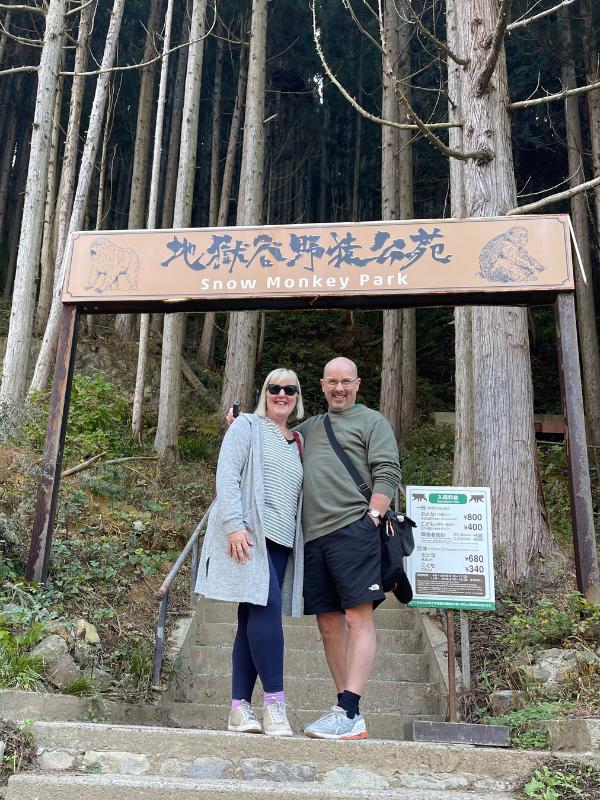
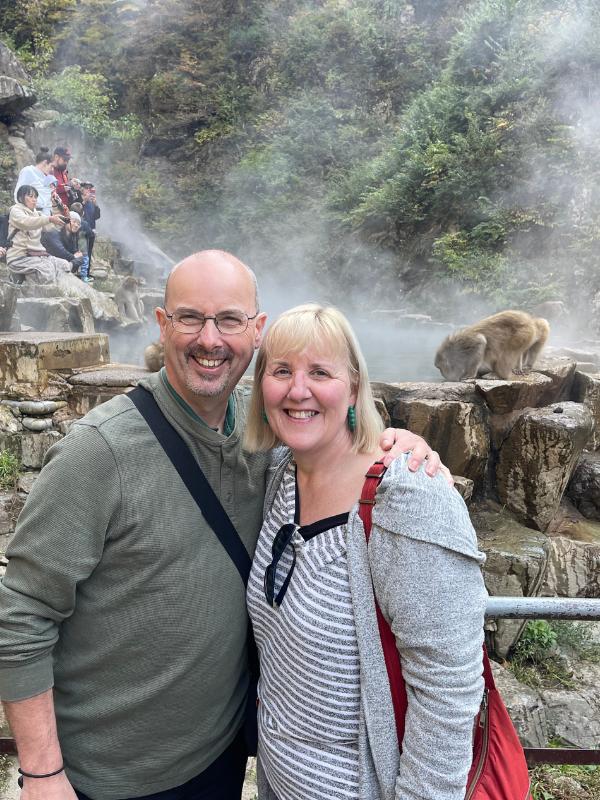
On Friday, 27 October, we spent the day visiting one of Japan’s most unique wildlife experiences — the Jigokudani Monkey Park, home to the famous snow monkeys (Japanese macaques) that soak in natural hot springs.
🐒 Visiting the Snow Monkeys at Jigokudani Monkey Park
In the morning, we were kindly given a lift to the park by the owner of our ryokan, along with two lovely Japanese women who were also visiting the area. Interestingly, they both lived in Greece with their Greek husbands and were holidaying together around Japan.
To reach the monkeys, you need to walk around 1.6 kilometres each way (just under a mile) along a forest trail. The walk is scenic and not difficult, but it can become slippery or icy in colder months, especially from November onward.
Tip: Wear sturdy, non-slip footwear. The path to the monkey park can be muddy, uneven, or icy depending on the season.
Once you arrive, you’ll see the monkeys up close as they bathe, groom, and interact freely in their natural environment. It’s a fascinating sight and one of the few places in the world where you can witness wild monkeys enjoying hot springs.
Highlight: The monkeys are wild but used to humans. You’re asked not to touch or feed them, but you can get close enough for great photos.
🏘️ Exploring Shibu Onsen
After visiting the monkey park, we were unexpectedly given another lift by our ryokan host, who happened to be parked near the exit. She kindly dropped us off in Shibu Onsen, a charming historic town nearby known for its narrow lanes, wooden buildings, and traditional bathhouses.
We spent around 30 minutes exploring the streets of Shibu Onsen. It’s a great place for a gentle stroll, with nostalgic atmosphere and several public onsens that locals and visitors use.
🍱 Return to the Ryokan
After our walk, we returned on foot to our ryokan in Yudanaka and enjoyed another beautifully presented traditional Japanese dinner. This slower-paced day combined nature, culture, and comfort, a perfect balance in the middle of our itinerary.
Day 9 – From Yudanaka to Takayama via Nagano
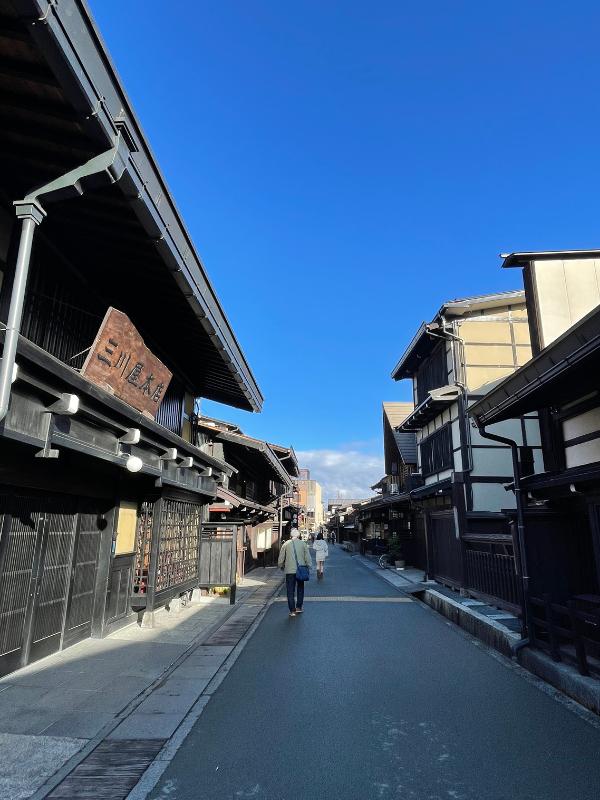
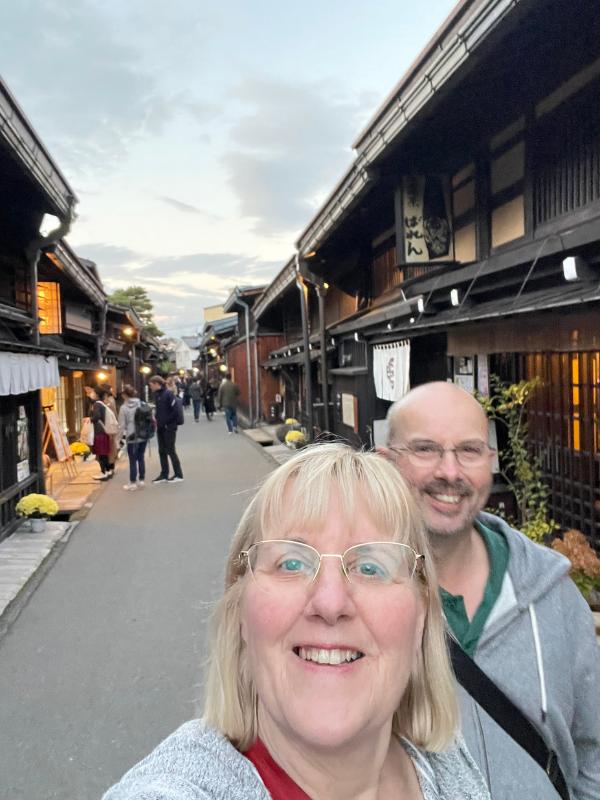
On Saturday, 28 October, we said goodbye to Yudanaka and continued our journey into the Japanese Alps, heading for the charming town of Takayama.
🚆 Train: Yudanaka to Takayama (via Nagano)
We began by returning to Nagano Station, using the same Nagano Dentetsu Line we had arrived on. Tickets for this route can be purchased on the day and are readily available at the station.
From Nagano, we boarded a limited express train to Takayama. This scenic journey takes approximately 1 hour and 30 minutes and is covered by the Japan Rail Pass (at the time of our trip, there was no additional supplement required).
Tip: Even though it’s a limited express service, this train can often be boarded without a reservation. However, booking a seat in advance can guarantee comfort, especially during peak seasons.
🏨 Hotel Check-In: Takayama
We stayed at the Shizun Grand Hotel, conveniently located just a two-minute walk from Takayama Station, ideal when travelling with luggage.
🏘️Afternoon – Exploring Takayama’s Historic Old Town
After checking in, we set out to explore Takayama’s old town, one of the most beautifully preserved historic areas in Japan. The streets are lined with traditional wooden buildings, sake breweries, and merchant houses, some dating back to the Edo period.
Walking through its narrow streets lined with traditional merchant houses, you’ll feel like you’ve stepped back in time.
One of the main areas to explore is Sanmachi Suji, a beautifully maintained street where many of the wooden buildings have been turned into museums, shops, and cafes. This district is particularly photogenic and very walkable.
Here are some of the highlights not to miss:
- Sake Breweries
Takayama is famous for its local sake. Along Sanmachi Suji, you’ll find several small breweries offering tastings. Look out for a sugidama (a ball of cedar branches) hanging above the entrance — a traditional sign of a sake brewery. - Craft and Souvenir Shops
You’ll find a range of locally made goods such as lacquerware, ceramics, and wooden crafts, many of which make for beautiful souvenirs. The shops here focus on quality, traditional craftsmanship rather than mass-produced items. - Street Snacks and Sweet Shops
As you wander, you can sample local specialities like mitarashi dango (grilled rice dumplings with soy glaze), Hida beef skewers, or sarubobo dolls – a traditional charm often sold in Takayama as a symbol of protection and good luck. - Historical Houses and Museums
Many buildings in the area have been preserved as small museums. These offer insight into how merchants lived and worked centuries ago. The Takayama Jinya, a former government office just a short walk away, is also worth a visit for its historical exhibits and well-kept interiors.
Tip: Try visiting early in the morning or late afternoon to enjoy the peaceful atmosphere with fewer tourists and better lighting for photos.
Takayama’s old town is compact, easy to navigate on foot, and full of charm — ideal for those who want to enjoy traditional architecture, sample local delicacies, and take things at a slower pace.
The town has a relaxed, almost village-like atmosphere, making it a perfect stop to soak up Japanese history and rural charm.
Day 10 – From Takayama to Kanazawa via Toyama
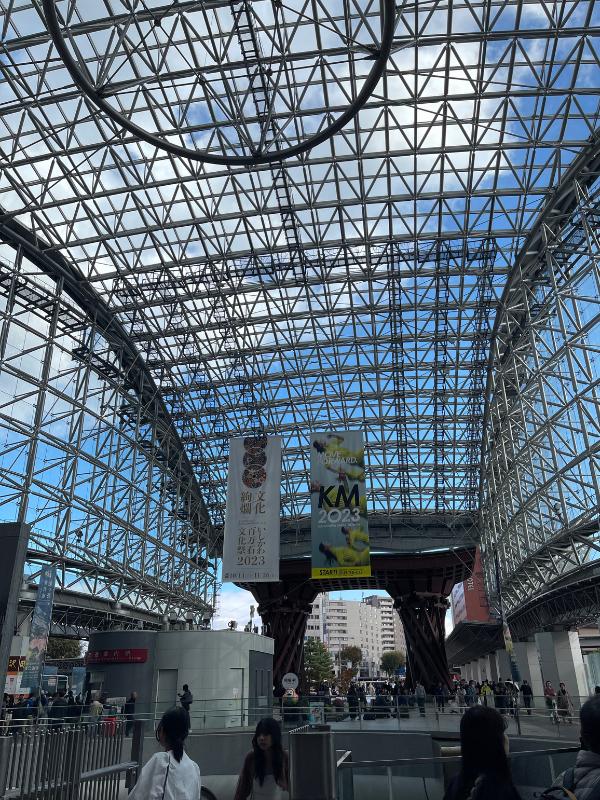
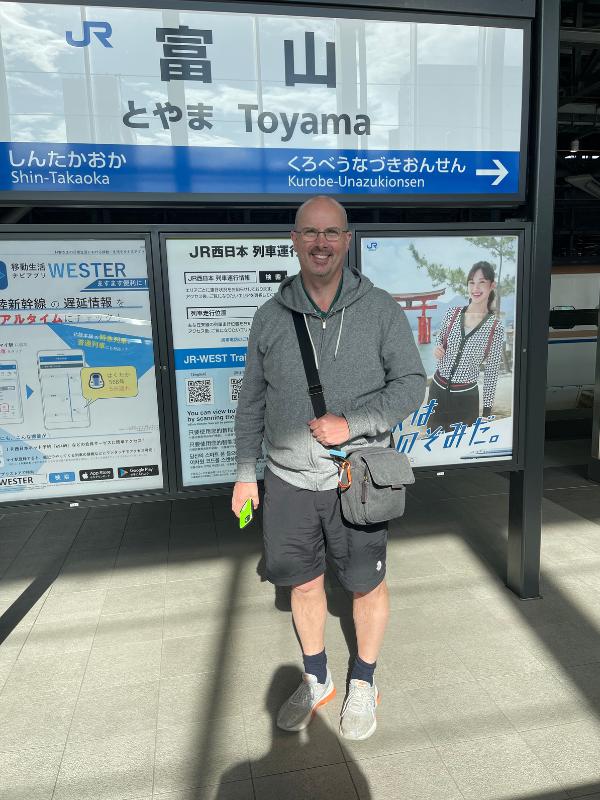
On Sunday, 29 October, we travelled from Takayama to Kanazawa, with a simple train change at Toyama along the way.
🚆 Takayama to Kanazawa by Train
We first boarded the Hida Limited Express from Takayama to Toyama, a scenic route that takes approximately 1 hour and 30 minutes, winding through the mountains and showcasing some beautiful Japanese countryside.
From Toyama, we transferred to a second train for the short journey to Kanazawa. The entire route was efficient and comfortable, and the connection at Toyama Station was easy to manage.
🏨 Arrival in Kanazawa
We arrived in Kanazawa in the afternoon and checked into the Weskii Hotel, our base for the next two nights. The hotel was conveniently located near the station, making it easy to explore the area.
🍱 Kanazawa Station Food and Shopping
After settling in, we explored the Kanazawa Station shopping and food area, which is well worth a visit in its own right. Like many larger Japanese train stations, it’s home to a range of excellent department store-style food halls and souvenir shops.
We were particularly impressed by the beautifully presented takeaway meals and snacks — a signature of Japanese culinary culture. Even everyday meals are treated with care, both in preparation and packaging.
Tip: Always check out the shopping and food halls at major train stations. From boxed bentos to high-quality sweets and snacks, they’re perfect for gifts or train journey treats and the presentation is often exquisite.
Day 11 – Exploring Kanazawa by Hop-On Hop-Off Bus
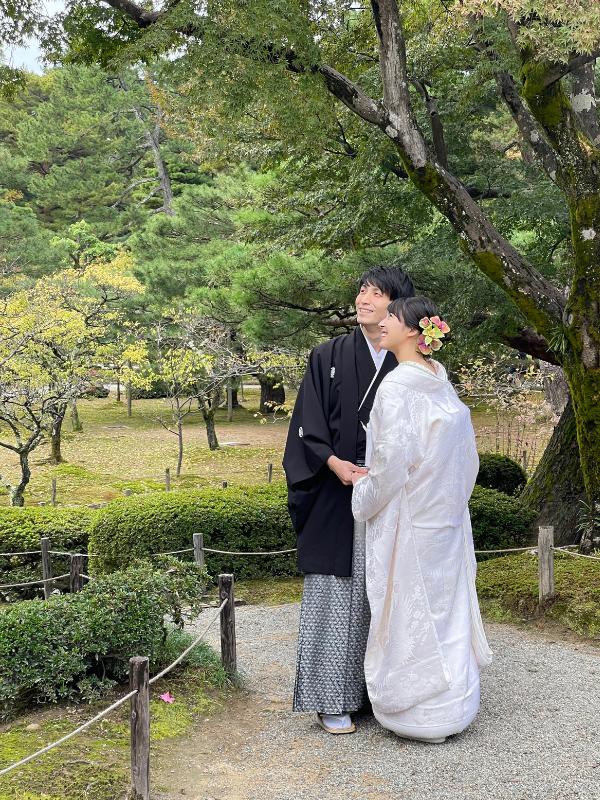



On Monday, 30 October, we explored Kanazawa using the city’s hop-on hop-off bus service, which is a great option for seeing the major attractions efficiently.
We picked up our tickets at the Kanazawa Station Tourist Information Centre, conveniently located next to the station. The service includes two main routes, the Right Loop and the Left Loop, each covering different parts of the city with clearly numbered stops.
🚌 Right Loop Highlights
We used the Right Loop bus to visit several key areas around the city:
- Stop 6: Kanazawa Castle and Kenroku-en Garden
These are two of Kanazawa’s most iconic sights. The castle is partially reconstructed but gives a great insight into Edo-period architecture, while Kenroku-en is one of Japan’s top three traditional landscape gardens — a must-see for first-time visitors. - Stop 10: Teramachi Temple District
We explored this peaceful area full of historic temples and had lunch at a small temple café, which was a unique and tranquil spot to relax. - Stop 14: Omicho Market
Kanazawa’s bustling seafood market is a great place to try local delicacies like sushi, fresh oysters, and grilled skewers. Even if you don’t eat seafood, the atmosphere and variety of stalls make it worth a visit. - Stop 4 (via the station): Higashi Chaya District
Known for its traditional geisha teahouses and preserved Edo-period streets, this area is perfect for a gentle stroll and photographs. Some of the teahouses are open to the public, offering a glimpse into Kanazawa’s geisha culture.
🔄 Switching to the Left Loop
After our sightseeing, we switched to the Left Loop bus at Stop 11, which returned us to Kanazawa Station. This is a different route and vehicle from the Right Loop, so it’s worth checking the signage when boarding.
🍽️ Evening
We returned to the WESQUE Hotel after dinner (details not essential), completing a full and varied day of sightseeing. The hop-on hop-off bus was a cost-effective and straightforward way to navigate Kanazawa, and we recommend it if you’re visiting the city for the first time.
Tip: Start early to make the most of the bus routes and allow time at each major stop. Tickets are valid for unlimited rides throughout the day.
Day 12 – Train to Kyoto and Evening Trip to Osaka for TeamLab Botanical
On Tuesday, 31 October, we travelled from Kanazawa to Kyoto on the Limited Express Thunderbird 22, departing at 12.14 pm and arriving in Kyoto at 2.37 pm. From the station, we walked about 15 minutes to check into our accommodation, Hotel Sakura Kyoto, a comfortable three-star hotel.
🧳 Luggage Forwarding Tip
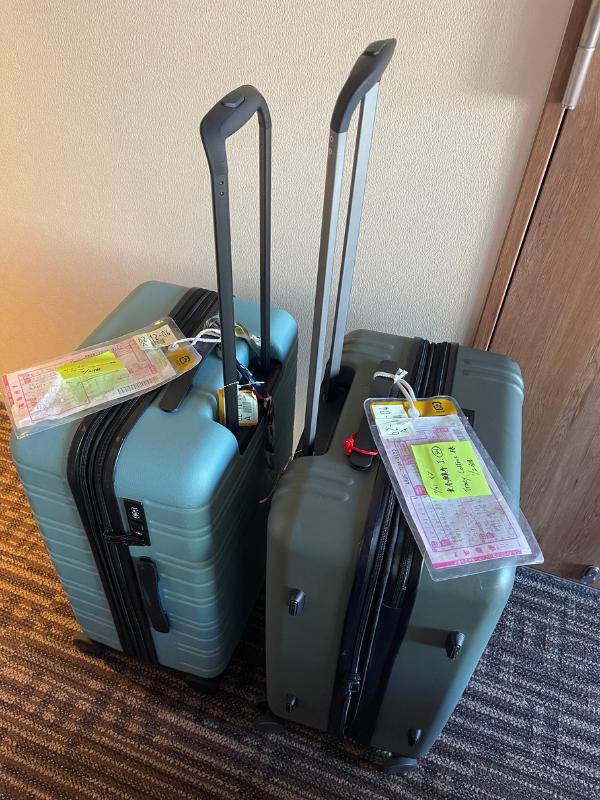
We had arranged for our luggage to be sent ahead from Tokyo using Japan’s excellent luggage forwarding service. It had been safely stored at our Kyoto hotel until our arrival, even after being held for a week. To track its location, we placed AirTags inside each suitcase, which gave us peace of mind and confirmed it had arrived before we did.
Tip: Luggage forwarding is reliable, affordable, and a great way to travel light between destinations. Adding AirTags or a tracking device is a smart option for extra reassurance.
🌃 Evening: TeamLab Botanical Garden in Osaka
That evening, we travelled to Osaka to visit TeamLab Botanical Garden, located in Nagai Botanical Garden. While visually striking, we didn’t find it as impressive as TeamLab Planets in Tokyo.
- Metro to Kyoto Station
- JR train to Osaka (approx. 30 minutes)
- Osaka metro (approx. 20 minutes)
The journey, although short on paper, felt long after a travel day, and we returned to Kyoto quite late.
Tip: If you want to visit TeamLab Botanical, consider doing so when you’re already staying in Osaka. It’s not ideal as an evening side trip from Kyoto.
Day 13 – Exploring Gion and Higashiyama






On Wednesday, 1 November, we explored Gion and the Higashiyama district, one of Kyoto’s most historic and culturally rich areas.
🚌 Getting There by Bus
We took Bus No. 80 to Gion. On Kyoto buses, it’s important to remember:
Bus Tip: Don’t tap your IC card when getting on. Instead, tap once at the front as you exit the bus. This is the standard system on most Kyoto city buses.
🏯 Sightseeing Highlights in Gion & Higashiyama
- Yasaka Pagoda (Hōkan-ji Temple)
Often referred to as the Tower of Yasaka, this five-story pagoda is one of the most iconic landmarks in Kyoto’s skyline. It’s especially striking when viewed along the narrow stone streets. - Tatsumi Bridge
A picturesque spot along the Shirakawa River, this is a classic Gion photo location, surrounded by traditional tea houses and willow trees. - Hanamikoji Street
The heart of Gion’s geisha district, this street is lined with preserved wooden machiya houses.
Note: Photography is not permitted on certain parts of Hanamikoji Street to protect residents’ privacy and preserve the atmosphere. Be respectful of local signage. - Yasaka Shrine
A vibrant Shinto shrine at the edge of Gion, open 24 hours and known for its lantern-lit paths and seasonal festivals. - Ryōzen Kannon
A striking 24-metre tall statue of Kannon (the Goddess of Mercy), built to honour those who died during World War II. The quiet memorial site offers a moment of reflection amid the city’s historic bustle.
🛒 Simple Kyoto Supermarket Tip
We picked up dinner and snacks from Fresco, a local supermarket chain in Kyoto. It’s a convenient option if you’re looking for fresh salad, fruit, or ready-made meals.
Tip: If you need a lighter or self-catered meal, Kyoto’s supermarkets (like Fresco or Aeon) are well-stocked, affordable, and often open late.
Day 14 – Sunrise at Fushimi Inari, Temples, Nishiki Market and Gion
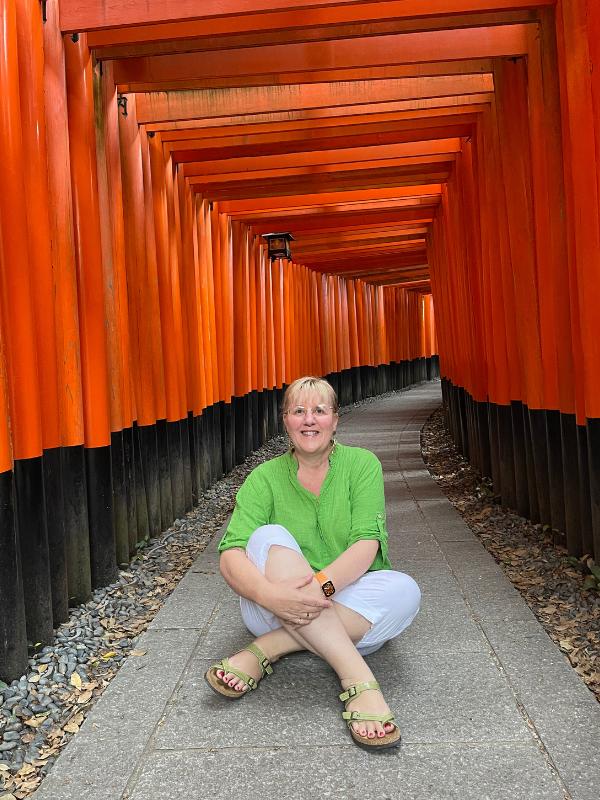


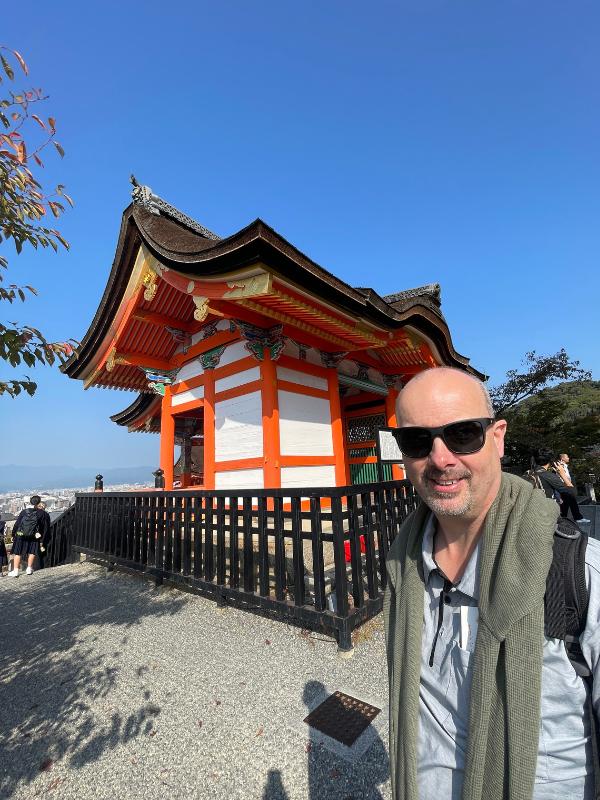
On Thursday, 2 November, we packed a lot into the day by starting early and focusing on some of Kyoto’s most famous sights, along with a few personal experiences that made the day extra memorable.
🌅 Early Start: Fushimi Inari Taisha
We began the day with a 6.40 am start to beat the crowds at Fushimi Inari Shrine, famous for its thousands of bright red torii gates that trail up the mountainside. Early morning is the best time to visit — it’s peaceful, atmospheric, and perfect for photos without crowds.
Tip: If you want to walk the full route up the mountain, allow at least 1.5 to 2 hours. Even a short walk through the lower gates is stunning if you’re short on time.
🏯 Kiyomizu-dera Temple
After Fushimi Inari, we headed to Kiyomizu-dera, one of Kyoto’s most celebrated temples. The wooden stage, which juts out from the hillside, offers panoramic views over the city. The temple complex includes smaller shrines and the famous Otowa Waterfall.
Tip: Be prepared for some uphill walking and busy paths, especially later in the morning. Arriving early helps avoid the crowds.
🛍️ Nishiki Market and Personal Adventures
We then took a bus to Nishiki Market, a bustling covered street market in central Kyoto filled with food stalls, local snacks, kitchenware shops, and fresh seafood.
- Tracy visited a Dog Café, a fun and quirky experience where visitors can relax and interact with friendly dogs in a cosy indoor setting.
- Doug explored the surrounding fish market and alleyways, soaking up the atmosphere and browsing the market’s traditional offerings.
Tip: While the market gets crowded, it’s worth visiting for the variety of street food, including skewers, matcha sweets, and pickled vegetables. Many vendors offer small portions, so you can try lots of different items.
🌙 Evening Walk in Gion
Later in the day, we returned to Gion for another walk through the historic district. In the early evening, the streets become especially atmospheric, with soft lighting and the chance to spot a geiko or maiko (Kyoto’s geisha) on their way to evening appointments.
Tip: Stay quiet and respectful if you do spot a geisha they are not performers for tourists, and photos should not be taken even from a distance.
Day 15 – Day Trip to Nara and Preparing for Hiroshima
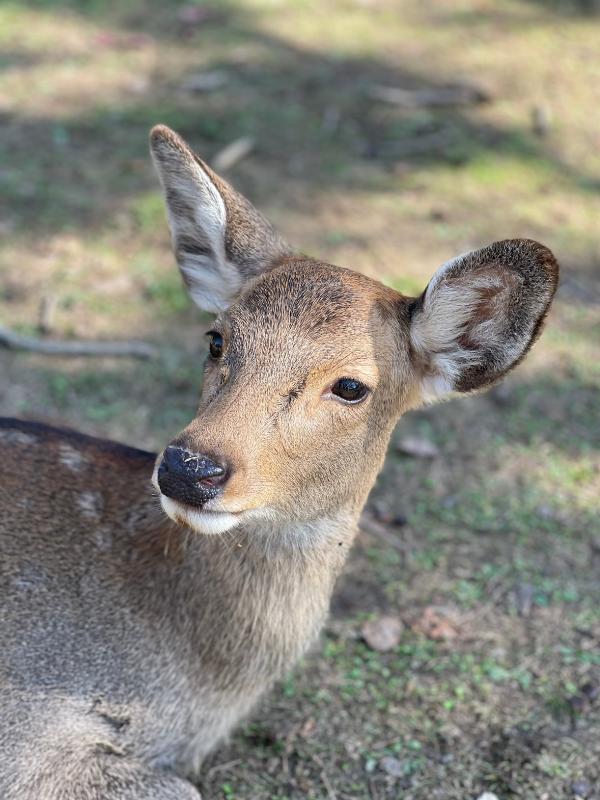




Today we took a day trip from Kyoto to Nara, one of Japan’s ancient capitals. Known for its relaxed atmosphere, sacred deer, and UNESCO-listed temples, Nara is an easy and rewarding destination, less than an hour by train from Kyoto. However, as it was a public holiday in Japan, the sites and trains were noticeably busier than usual.
Exploring Nara’s Cultural Treasures
Nara offers a rich blend of history and nature, and our first stop was the famous Nara Park, where over a thousand semi-wild Sika deer roam freely. Considered sacred messengers in the Shinto religion, they’ve become an iconic part of the city. Feeding them is part of the fun and you can purchase special deer crackers (shika senbei), though be warned, the deer can be a little too enthusiastic!
We also visited Tōdai-ji Temple, one of the most significant temples in Japan. It houses the Great Buddha (Daibutsu), a monumental 15-metre bronze statue housed inside one of the largest wooden buildings in the world. It’s a truly awe-inspiring sight and one of the must-sees in Nara.
Other nearby highlights include Kasuga Taisha Shrine, famous for its hundreds of stone and bronze lanterns, and Kōfuku-ji Temple, once one of the Seven Great Temples of Nara. The peaceful walking trails through the surrounding hills and wooded areas added a serene contrast to the busy temple grounds.
Travel tip: If your schedule allows, consider visiting Nara on a weekday rather than a public holiday or weekend, as crowds can be particularly intense. And wear comfortable shoes – there’s plenty of walking involved if you want to explore the main attractions at a leisurely pace.
🍽️ Dinner at Kyoto Station

After returning to Kyoto in the evening, we stopped at Kyoto Station for dinner and had okonomiyaki, a savoury Japanese pancake that was particularly good, filling, tasty, and a great way to end the day.
🧳 Luggage Forwarding to Osaka
That evening, we organised our luggage for forwarding using Japan’s reliable Yamato service.
- We were heading to Hiroshima next, but instead of taking all our luggage with us, we forwarded our main suitcases directly to our hotel in Osaka, where we would stay after Hiroshima.
- For Hiroshima, we travelled light, just bringing smaller overnight bags with us.
This made the upcoming travel days much easier and more comfortable.
Tip: If you have multiple city stops planned, consider using luggage forwarding to skip the hassle of carrying everything with you. Sending large suitcases ahead to your next major base (like Osaka) and travelling with a smaller bag makes train travel far more enjoyable.
Day 16 – Luggage Arrival and Exploring Kyoto’s Iconic Temples
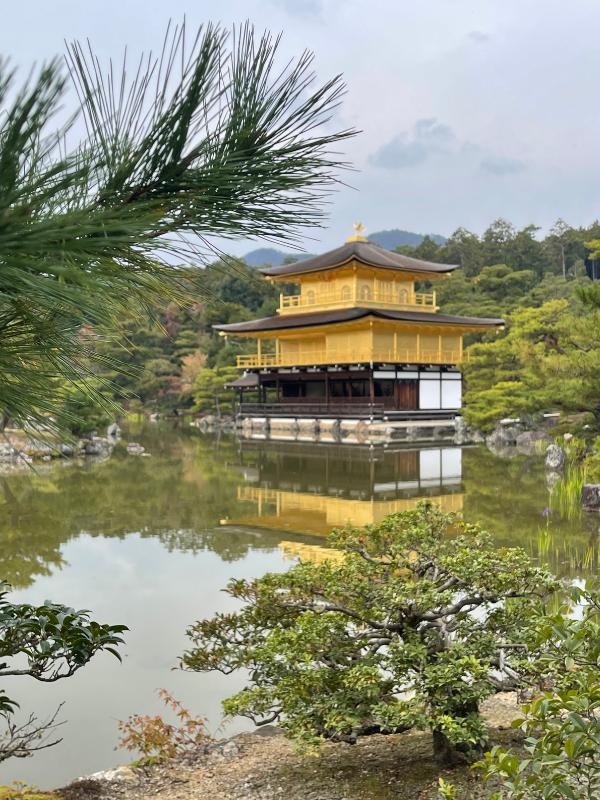



On Saturday, 4 November, we spent the day visiting two of Kyoto’s most famous temples – the Golden Pavilion and the Silver Pavilion – as well as enjoying some time in the Gion District in the evening. We also had the peace of mind of knowing our luggage had arrived safely from Kanazawa.
🧳 Luggage Forwarding – Arrival at Osaka
Although we were still in Kyoto, our main luggage had already been delivered to our hotel in Osaka using Japan’s luggage forwarding service. It had been sent from Kyoto via 7-Eleven, which made the process easy and convenient.
Important tip: Luggage forwarding via 7-Eleven has become more difficult unless you already have your next hotel address printed in Japanese and all the details ready. We were fortunate to have everything properly prepared, which made the drop-off process simple. It’s worth organising this in advance, especially if your Japanese language skills are limited.
🚌 Golden Pavilion (Kinkaku-ji)
Our day of sightseeing began with a bus ride to Kinkaku-ji, also known as the Golden Pavilion. This Zen Buddhist temple is one of the most recognisable sights in Kyoto, famous for its shimmering gold leaf exterior that reflects beautifully in the surrounding pond.
Kinkaku-ji (Golden Pavilion)
Our visit to Kinkaku-ji, also known as the Golden Pavilion, was one of the most visually striking moments of our time in Kyoto. The temple’s upper floors are famously covered in gold leaf, and they shimmer in the sunlight, reflecting beautifully onto the still waters of the pond below. The entire setting feels like it has been composed for maximum visual impact, with every angle offering a postcard-perfect scene.
Despite the large crowds, which are almost unavoidable here, the pavilion still manages to leave a strong impression. It’s easy to understand why this site is considered one of Kyoto’s most iconic.
We took plenty of photographs, although capturing a shot without other visitors in the frame proved quite difficult. Even so, the setting is undeniably beautiful, and the golden structure surrounded by trees and water feels almost surreal.
While you can’t enter the pavilion itself, the walking path guides you around the pond and through carefully maintained gardens, giving you the chance to see it from various perspectives.
The surrounding grounds are equally elegant, with smaller shrines, statues, and tea shops that add to the overall atmosphere. It’s a place that leaves a strong visual memory, and despite the busyness, we thought it was well worth the visit.
🏯 Silver Pavilion (Ginkaku-ji)
After Kinkaku-ji, we took a bus across town to Ginkaku-ji, the Silver Pavilion. Unlike its name suggests, it is not actually silver, but it has a beautifully simple and serene aesthetic. The grounds include a sand garden, moss garden, and a hillside trail with city views.
Our visit to Ginkaku-ji, the Silver Pavilion, was a highlight of the day. While it may not be covered in silver as its nickname suggests, this Zen temple has a quiet elegance that makes it truly special. The setting is peaceful, and the design of the gardens and structures feels very deliberate and balanced.
The temple is surrounded by a beautifully landscaped garden that includes a famous white sand garden with a sculpted cone of sand symbolising Mount Fuji, as well as a lush moss garden that adds a layer of natural softness to the space.
There’s a walking path that loops up around the hill behind the temple, providing stunning elevated views of the temple rooflines, the surrounding gardens, and even the Kyoto cityscape through the trees. It was especially scenic during our visit, and we managed to take some beautiful photographs throughout the grounds.
Although it was quite busy when we visited, it still felt like a calm and reflective place to walk through. We really enjoyed following the winding path through the different parts of the garden, taking in the changing views from different angles. Ginkaku-ji may not dazzle in the way some of Kyoto’s more elaborate temples do, but it offers a quiet charm that’s just as memorable in its own way.
🌆 Evening in Gion and Kyoto Station
In the evening, we headed back to Gion, Kyoto’s historic geisha district, and then made our way to Kyoto Station for dinner. There are plenty of options for food and shopping within the station complex, which is especially convenient when you’re travelling or finishing a busy day.
🚌 Getting Around by Bus
We travelled throughout the day using Kyoto’s public bus system. It’s an affordable and efficient way to get around, but here’s a reminder:
Kyoto Bus Tip: Only tap your IC card once when exiting the bus at the front — not when you get on.
Day 17 – Hiroshima and the Atomic Bomb Memorials
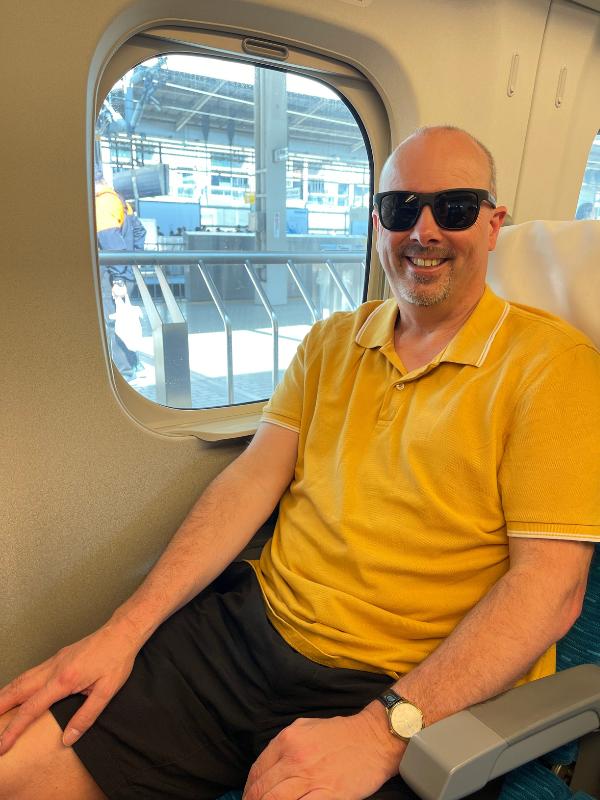


On Sunday, 5 November, we travelled to Hiroshima by Shinkansen, taking the Nozomi service, which is the fastest of the Tokaidō/Sanyō Shinkansen trains. This journey from Kyoto to Hiroshima is quick and efficient, taking around 1 hour and 40 minutes, depending on the train and connections.
Once we arrived in Hiroshima, we spent the day walking and reflecting as we visited several key historical sites related to the atomic bombing of the city during World War II.
A-Bomb Dome and Peace Memorial Park
We began at the Atomic Bomb Dome (Genbaku Dome), one of the few structures left standing near the hypocentre of the 1945 bombing. Preserved in its ruined state, it has become a UNESCO World Heritage Site and a stark, powerful symbol of the destruction caused by nuclear warfare.
Seeing it in person is confronting. The building is skeletal, yet moving in its resilience. It’s not a place to rush through. We found ourselves pausing to take in the quiet of the site, and to reflect on the human cost behind what we were seeing.
Day 18 – Miyajima Island and the Hiroshima Peace Memorial Hall

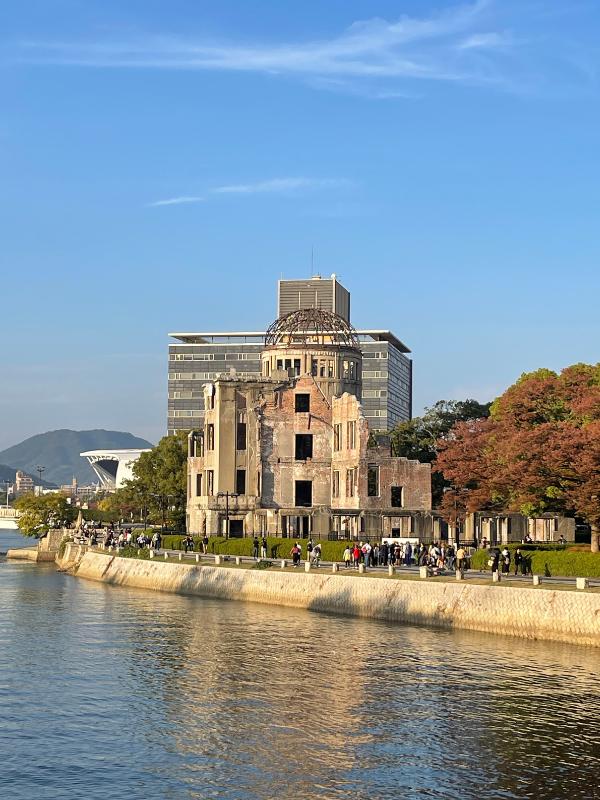
On Monday, 6 November, we split our day between two very different but equally memorable experiences: a morning trip to Miyajima Island, followed by an afternoon visit to the Hiroshima Peace Memorial Hall. We deliberately chose to separate these visits, as the emotional impact of the Peace Hall warranted space and reflection.
🦌 Morning: Visiting Miyajima Island


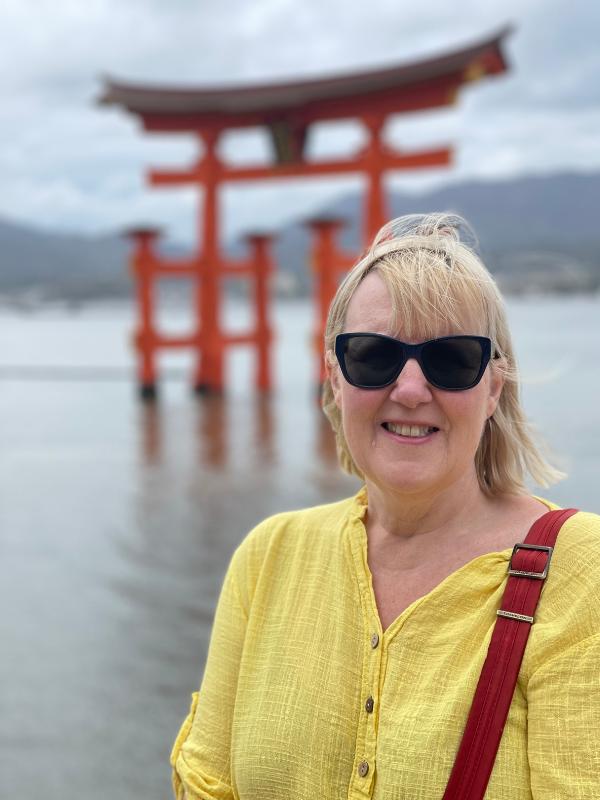
We started the day by taking a JR train from Hiroshima to Miyajimaguchi Station, followed by a short ferry ride to Miyajima Island (also known as Itsukushima). The journey is scenic and easy, and the island itself is a truly beautiful and peaceful place to explore.
Miyajima is famous for its floating torii gate, part of Itsukushima Shrine, which appears to float on the water at high tide. We were lucky to get some stunning photographs of the gate and the surrounding views. The shrine and its gate are among Japan’s most iconic sights — a must-visit if you’re in the region.
The island is also home to freely roaming deer, who are used to people and tend to approach visitors (especially if food is involved). While they add to the charm of the island, it’s worth being cautious with your belongings.
We spent time wandering the temple paths, enjoying the quiet beauty of the island, and soaking up the calm after the intensity of the previous day’s visit to Hiroshima city.
🕊️ Afternoon: Hiroshima National Peace Memorial Hall
In the afternoon, we returned to Hiroshima and visited the Hiroshima National Peace Memorial Hall for the Atomic Bomb Victims — a place we had intentionally postponed from the previous day. It was the right decision for us. The hall is emotionally intense, and separating it from the experience of visiting the A-Bomb Dome gave us the space to process everything properly.
The Memorial Hall is an underground space designed for quiet remembrance. It features photographs, recorded testimonies, and names of those who perished, all presented in a deeply respectful and moving way.
Tip: If you’re visiting Hiroshima, consider spacing out your visit to the Peace Memorial Park and the Peace Memorial Hall over two days. The weight of the experience can be emotionally overwhelming, and separating them gives you the space and time to reflect.
🏨 Where We Stayed in Hiroshima
We stayed at the Hotel Granvia Hiroshima, which we highly recommend. It’s located right next to Hiroshima Station, making it extremely convenient for arrivals, departures, and day trips like Miyajima. The location alone makes it an ideal choice, especially if you’re travelling by Shinkansen or planning to explore Hiroshima and the surrounding region with ease.
Tip: Staying near the station in Hiroshima saves time and hassle. Hotel Granvia offers comfort, convenience, and easy access to transport.
Day 19 – Return to Osaka and a Visit to the Kyoto Railway Museum


On Tuesday, 7 November, we left Hiroshima and returned to Osaka by Shinkansen. After several days of travel and emotional experiences, this day gave us a mix of practical transitions and personal interests – including a standout visit to the Kyoto Railway Museum.
🚄 Shinkansen: Hiroshima to Osaka
We boarded the Shinkansen from Hiroshima to Shin-Osaka, then transferred to a local train to Osaka Station. This route is fast and convenient, taking around 1 hour and 30 minutes in total, including the change at Shin-Osaka.
🏨 Hotel Check-in: Hankyu Respire Osaka
We checked into Hankyu Respire Osaka, a hotel we had chosen in advance for its excellent location and comfort. The hotel is directly connected to Osaka Station via a short walk and is part of a modern development with restaurants and shopping nearby.
Tip: If you’re planning to base yourself in Osaka for a few days, Hankyu Respire is a fantastic option thanks to its proximity to public transport and the amenities of the Umeda area.
🚄 Kyoto Railway Museum – A Must for Train Lovers
Later in the day, Doug returned to Kyoto to visit the Kyoto Railway Museum, and it turned out to be one of the highlights of the trip, a 10 out of 10 experience for him.
The museum offers an impressive and detailed look at the history and development of rail travel in Japan. It features dozens of real Japanese trains, ranging from early steam locomotives to classic bullet trains (Shinkansen), and modern high-speed models used today. There’s also a section showcasing trains from around the world, providing a fascinating comparison with Japan’s rail technology.
One of the most interesting parts of the museum is the interactive exhibits that explain how train systems work, including how speed is controlled, how train signalling functions, and how different engines evolved over time. It’s a museum that balances history, engineering, and fun really well.
Whether you’re a casual traveller or a serious rail enthusiast, the Kyoto Railway Museum is a brilliant stop. It’s clean, spacious, and thoughtfully laid out, with plenty of English signage. There’s also a model railway, simulator experiences, and observation decks overlooking live train lines.
Tip: Allow at least a few hours to fully enjoy the museum, especially if you’re interested in trains, transport, or Japanese engineering. It’s also very family-friendly and suitable for all ages.
Day 20 – A Taste of Osaka: Dotonbori and Final Explorations
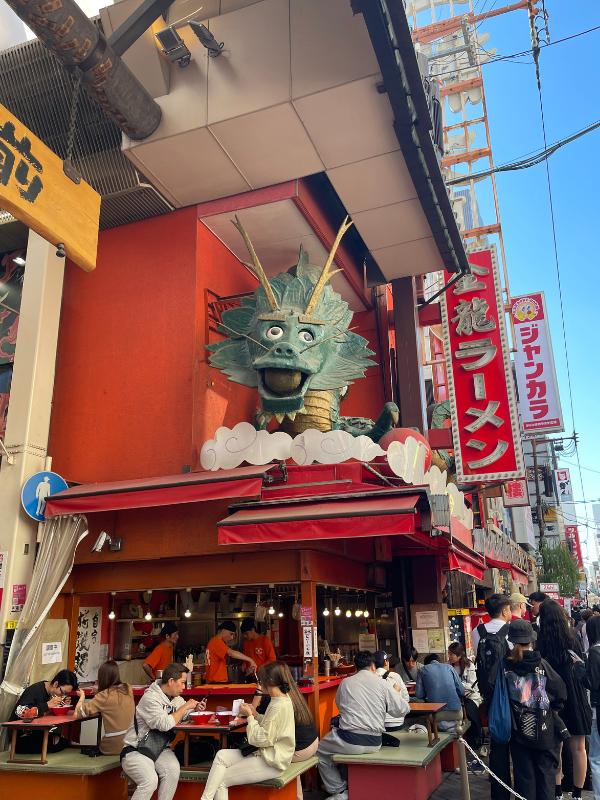
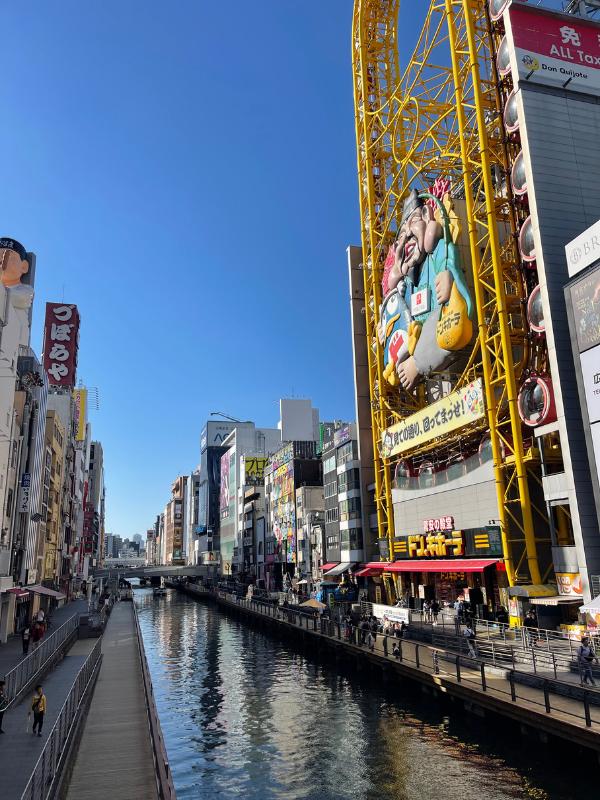
On Wednesday, 8 November, we spent our last full day in Japan exploring a small part of Osaka. By this point in our trip we were feeling the effects of a very full itinerary, so we kept things light and local.
🚇 Exploring Dotonbori and Namba
We took the Osaka Metro to Namba Station, just four stops from our accommodation near Osaka Station. From there, it’s an easy walk to the Dotonbori area, one of the most famous districts in Osaka, known for its colourful neon lights, giant restaurant signs, and lively energy.
We walked along the Dotonbori Canal, saw the iconic Glico running man sign, and browsed some of the nearby shops and food stalls. It’s a great area for street food and people-watching, and it truly comes alive at night.
Tip: If you’re not too tired, Dotonbori is best experienced in the evening when the neon lights are most impressive and the streets are buzzing with activity. Unfortunately, we didn’t stay into the evening as we were winding down from a very full trip, but it’s something we’d absolutely make time for on a return visit.
📝 A Note on Osaka
We realised that we hadn’t allowed ourselves quite enough time to properly explore Osaka. The city has a lot to offer, from modern shopping districts and vibrant nightlife to historical sites and unique neighbourhoods, and we only scratched the surface.
Tip: If you’re planning a similar trip, consider spending at least two full days in Osaka. There’s so much more to see than just Dotonbori, and it deserves its own place in your itinerary, not just a stop between Kyoto and your flight home.
Day 21 – Departure from Japan and Onward to Seoul

On Thursday, 9 November, we checked out of our hotel in Osaka and made our way to the airport for our flight to Seoul, South Korea. It was the end of an unforgettable 21-day journey across Japan.
🚌 Airport Transfer: Limousine Bus to Kansai International Airport
We took the limousine bus service to Kansai International Airport (KIX). The service was punctual, comfortable, and extremely convenient, especially with luggage. We highly recommend the limousine bus as an easy and stress-free way to get to the airport from central Osaka.
Tip: The limousine bus runs regularly from major hotels and transport hubs. Booking ahead is advisable, especially during busy travel periods.
What We Learned – Reflections from Our First Trip to Japan

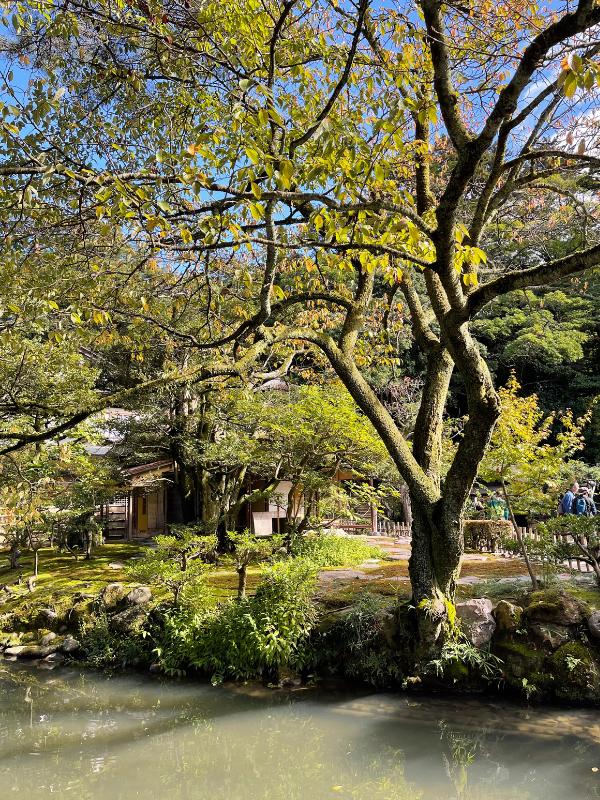
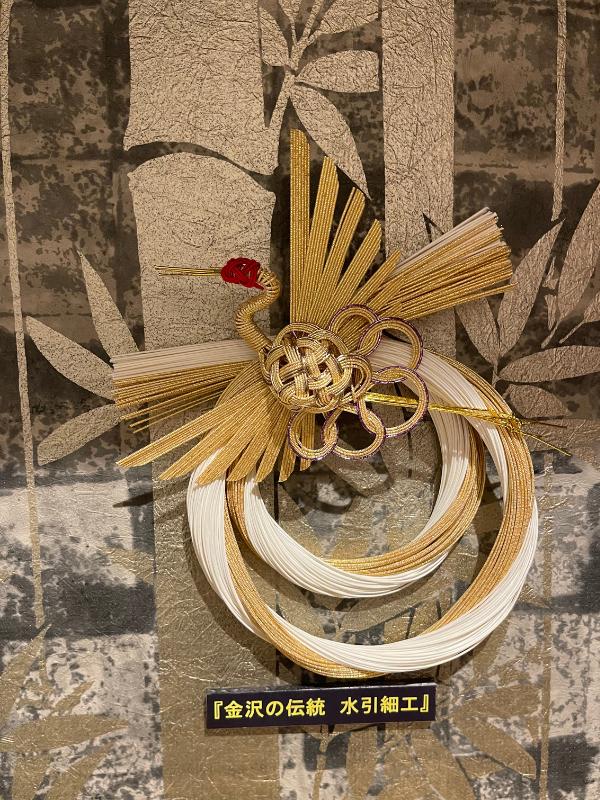
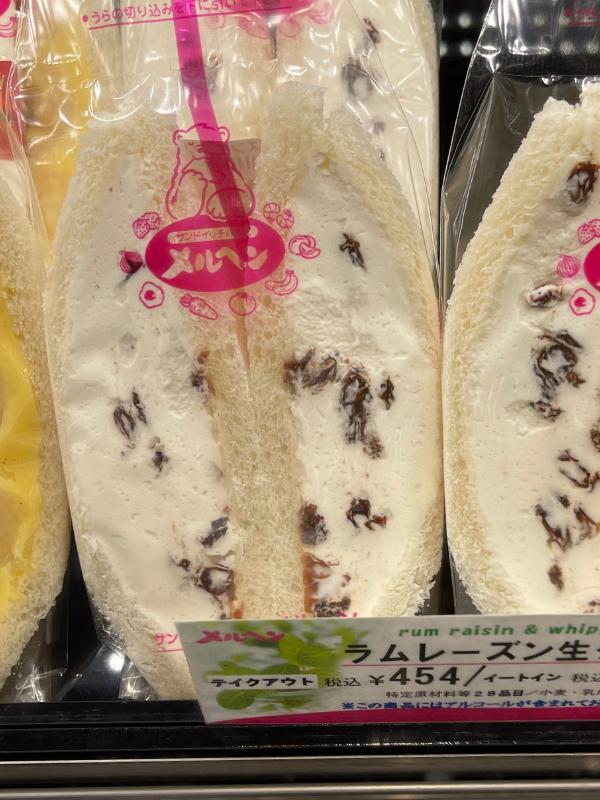
Looking back on our 21 days in Japan, there are a few things we learned that might help you when planning your own trip — especially if it’s your first time visiting.
- Pack Light
If we could change one thing, it would be to pack less. Navigating Japan’s excellent but often crowded transport system, especially when transferring between train stations and accommodations, would have been so much easier without large suitcases.
Tip: Use a backpack or smaller rolling case and take advantage of Japan’s luggage forwarding services wherever possible — they’re efficient and reliable.
- Stay Longer in Fewer Places
While we loved the variety in our itinerary, we’ve realised that slower travel has its benefits. Next time, we’d stay longer in Osaka, as we barely scratched the surface of the city. It’s full of culture, street food, and lively neighbourhoods — far more than we were able to experience during our brief time there.
- Consider Staying Near Mount Fuji
We visited Mount Fuji and Lake Kawaguchi on a day tour, and although we were fortunate to see Fuji on a clear day, it was a long and exhausting round trip from Tokyo.
In hindsight, we’d choose to stay overnight in the Fuji area, possibly in Hakone or Kawaguchik to have more time and better chances to enjoy the mountain and its surroundings without rushing back.
- Embrace Local Accommodation and Authentic Experiences
One of the things we loved most about Japan was the opportunity to stay in traditional ryokans, visit local markets, and enjoy regional cuisine. Travelling through different regions gave us a glimpse into the diversity of Japanese life and traditions.
Staying in smaller towns and local neighbourhoods allowed us to experience the country beyond the major tourist attractions — something we’ll aim to do even more next time.
Need to know!
🛂 What is a Suica Card (and Why You Should Use One in Japan)
If you’re planning to travel around Japan, especially in cities like Tokyo, a Suica card is one of the easiest and most convenient ways to pay for transport.
🚇 What is a Suica Card?
A Suica card is a prepaid IC card used for travel on trains, subways, and buses across many parts of Japan. It’s a tap-on, tap-off system just touch your card on the reader at the ticket gate, and the fare is automatically deducted. No need to queue for tickets or figure out the fare each time.
Originally issued by JR East, Suica works not only in Tokyo but also in many other major cities and regions, thanks to interoperability with other IC cards.
✅ Why is Suica Useful?
- No need to buy individual tickets for every journey — saves time and hassle
- Accepted across multiple transport systems, not just JR trains but subways and buses too
- Also works for small purchases at vending machines, convenience stores, station lockers, and even some restaurants
- Can be used in multiple cities, including Tokyo, Osaka, Kyoto, Hiroshima, Sapporo and more
🔁 Alternatives to Suica
Other regional IC cards work similarly and are interchangeable in most areas:
- PASMO (Tokyo)
- ICOCA (Kansai region – Osaka, Kyoto, Hiroshima)
- TOICA, Kitaca, SUGOCA, etc.
These all function the same way. If you already have a Suica, there’s no need to buy a different IC card when travelling to another region.
💡 Tip: You can also add your Suica or PASMO card to Apple Wallet (iPhone users) and top it up using Apple Pay — great if you want a digital option without carrying a physical card.
🛒 How to Get a Suica Card
There are a few options:
- Buy at a JR East station (look for ticket machines or JR East Travel Centres in Tokyo). A refundable ¥500 deposit is required for a physical card.
- Use a Welcome Suica (available for tourists only) – no deposit required, but it’s valid for 28 days and can’t be reissued if lost.
- Add to Apple Wallet – available for iPhone 8 or later, with a Japanese region setting (no deposit required).
💵 How to Top Up
- At train station machines or convenience stores (cash only for machines).
- For digital cards, top up via Apple Pay (iPhone) or other mobile payment methods.
Note: Suica cards (and other IC cards) were temporarily hard to purchase due to semiconductor shortages, but availability is now improving. If you’re planning a trip, check current availability and consider getting the mobile version in advance.
Read Next – Japan Travel Guide



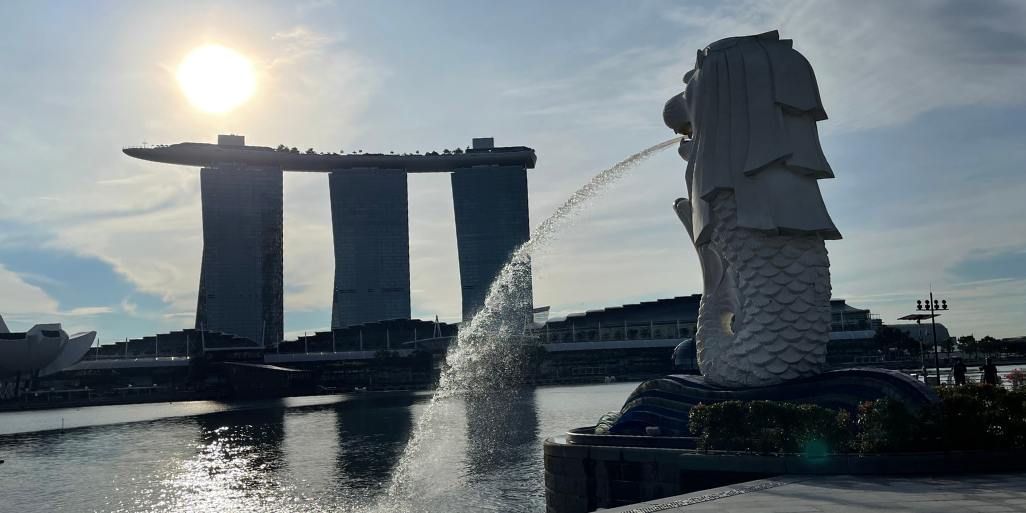


![Episode 58 Ultimate First-Timer’s Guide to Tasmania [lutruwita]: Tips + See, Do, Eat, Experience](https://globaltravelplanning.com/wp-content/uploads/2025/06/GTP-Podcast-Jen-in-Tasmania.jpg)
